
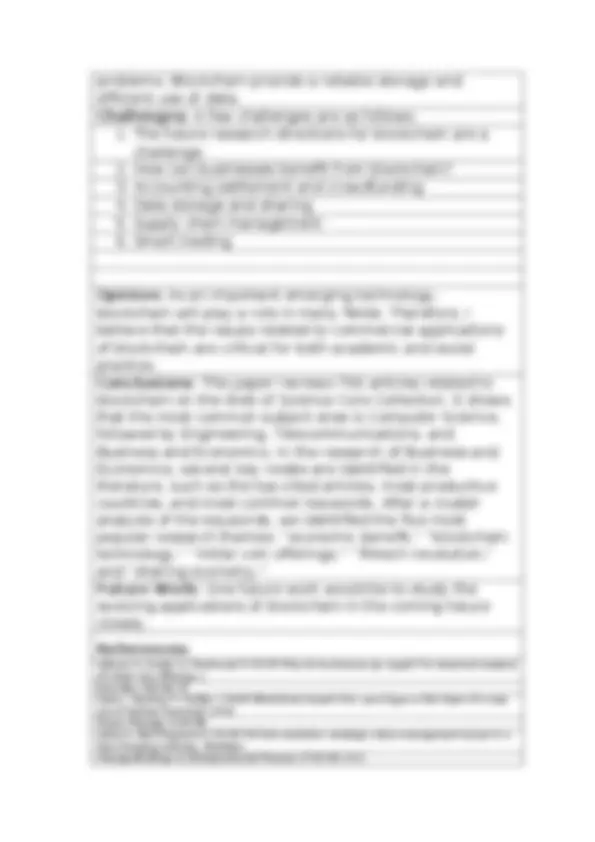





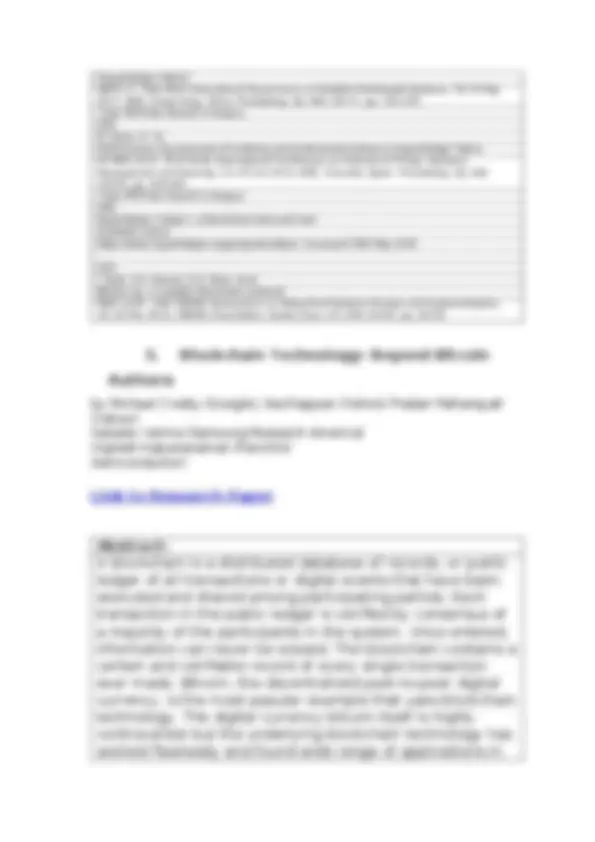
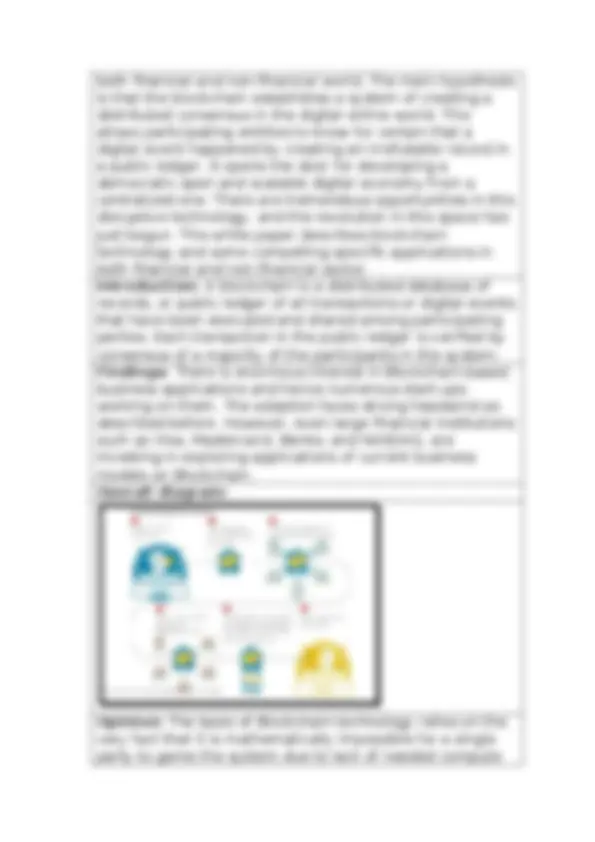
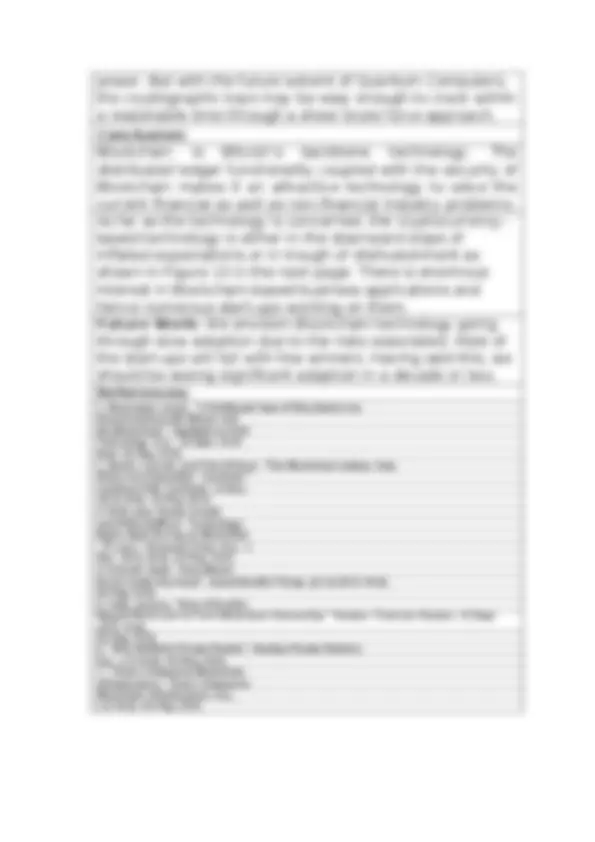
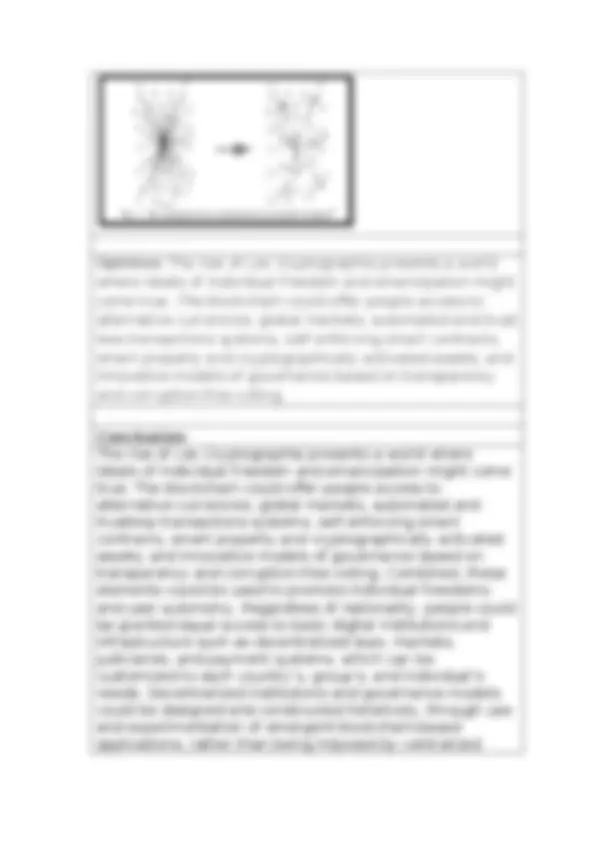
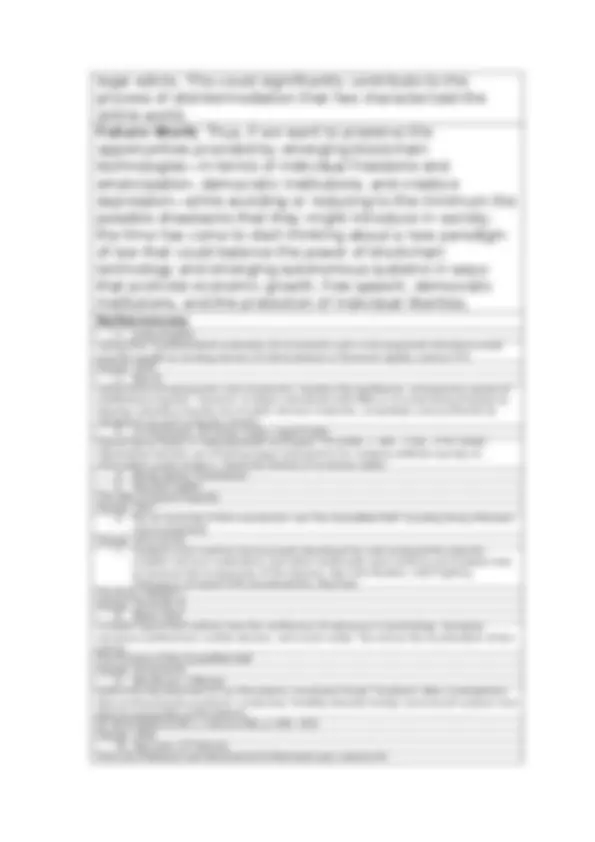
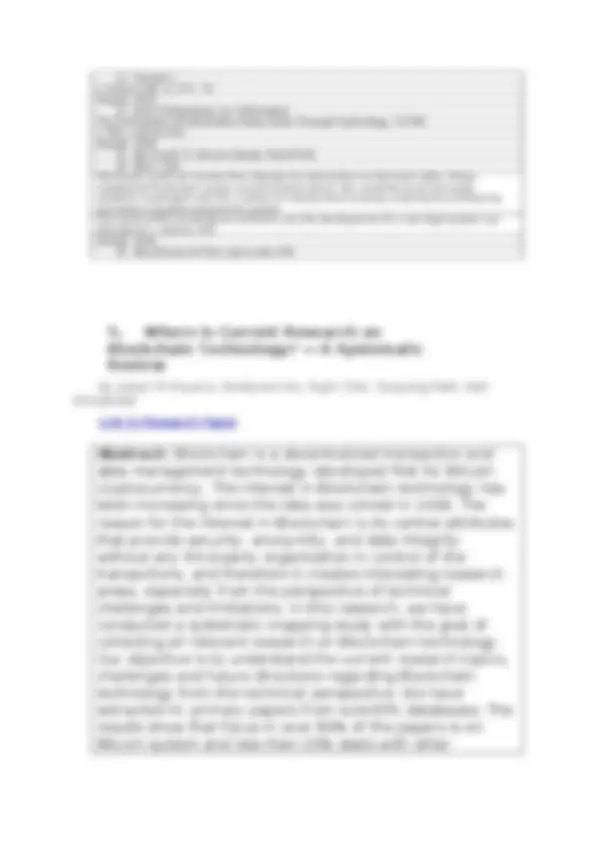
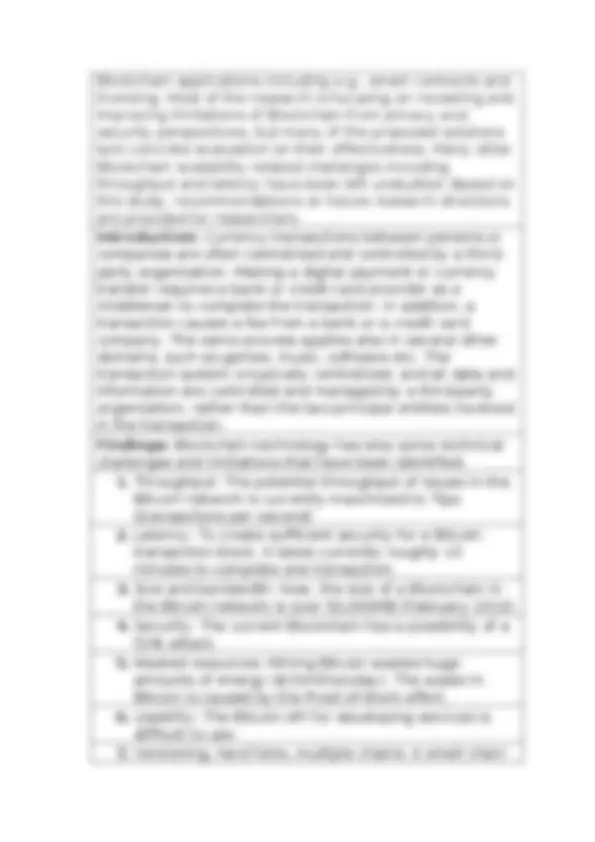
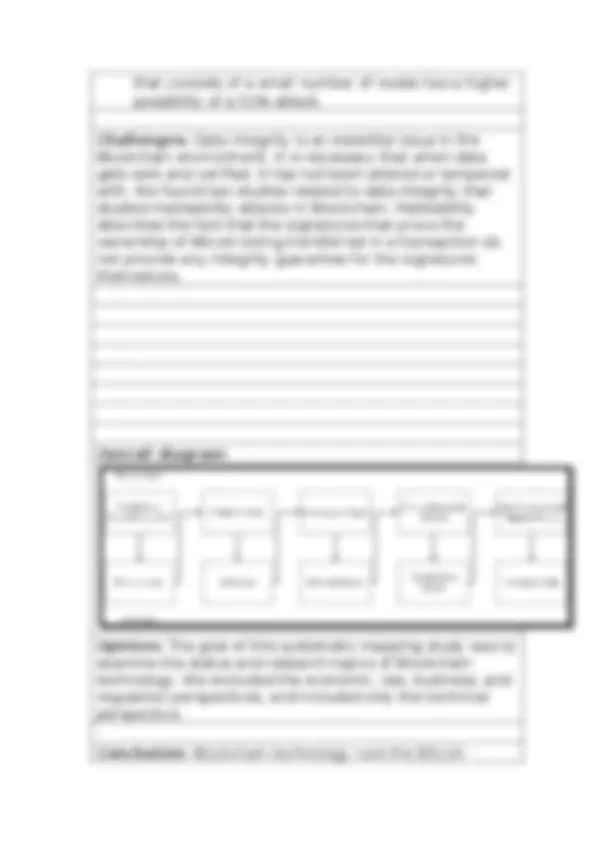
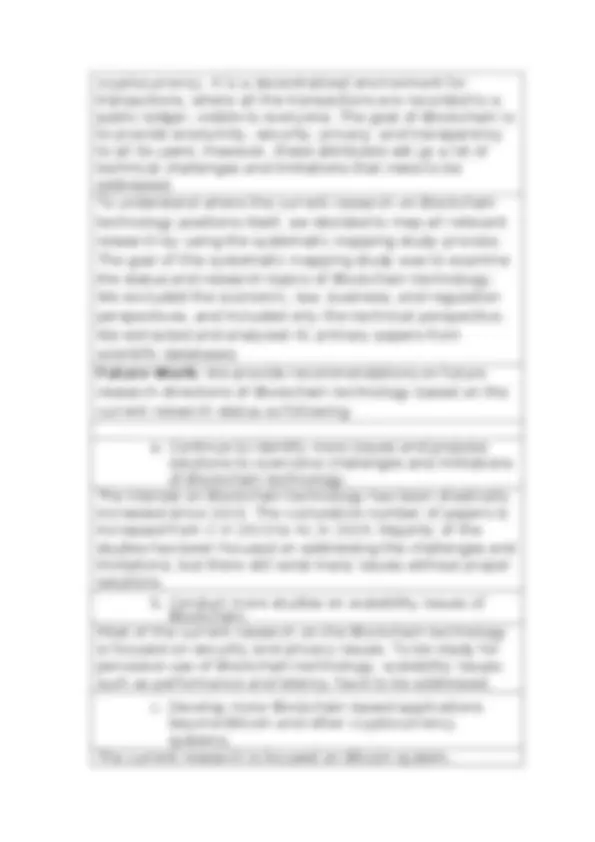
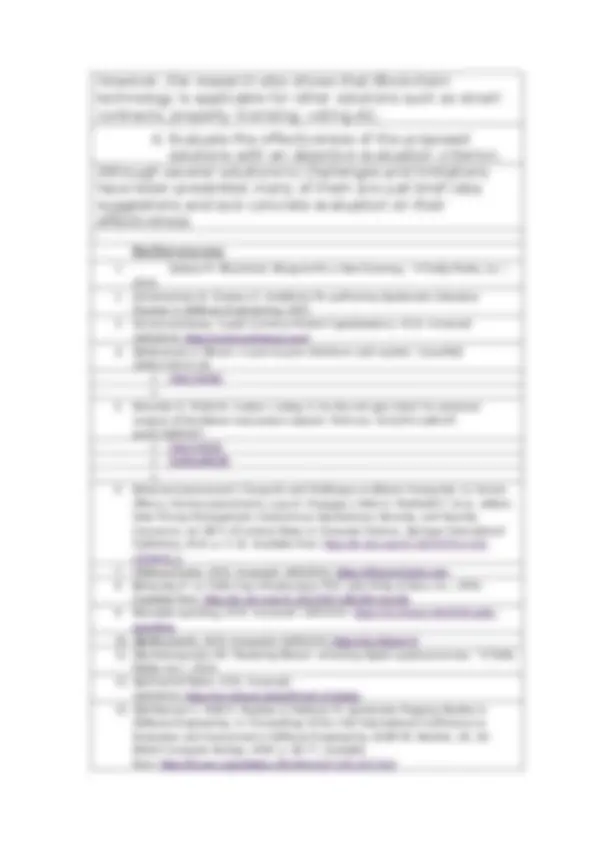
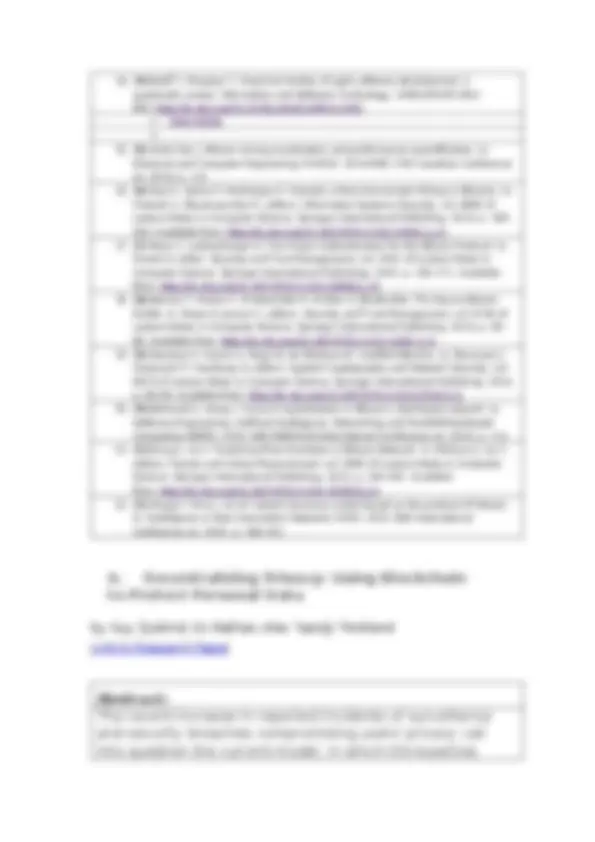
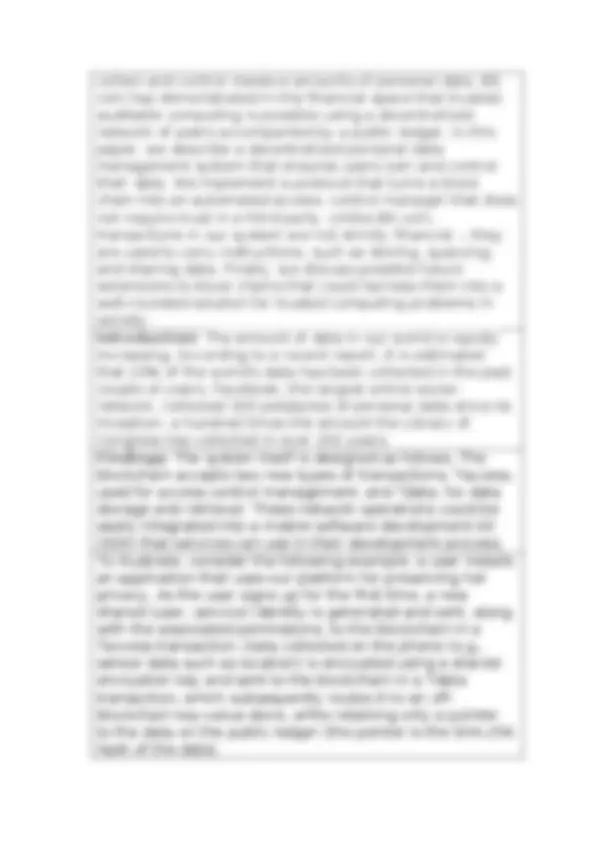
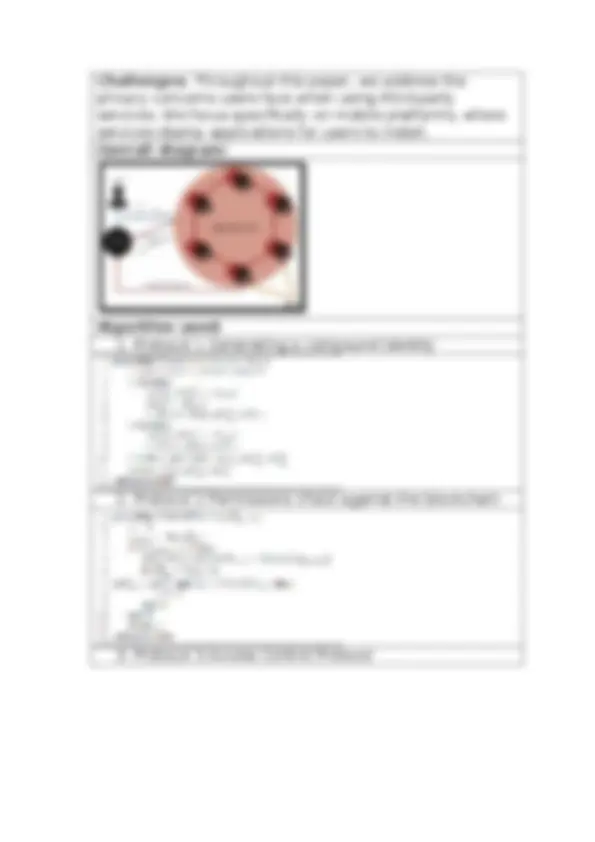

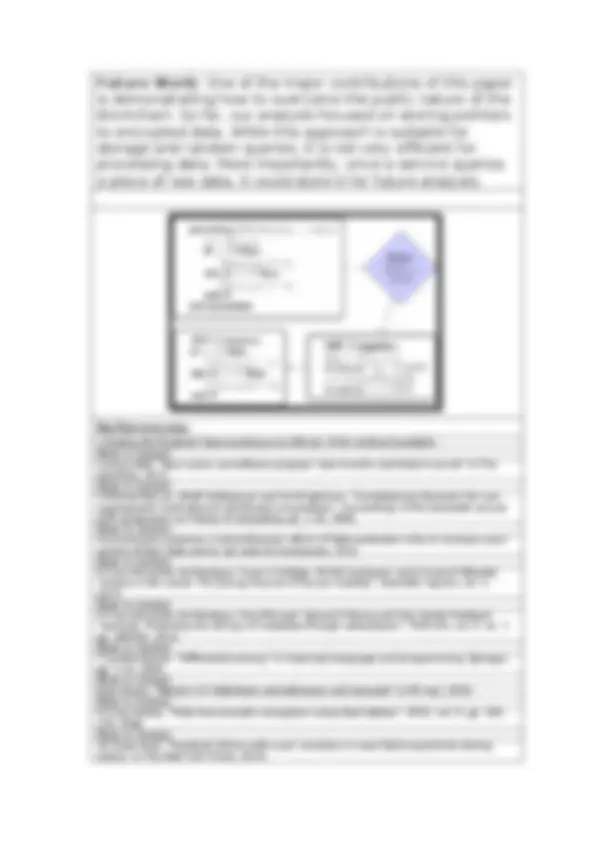
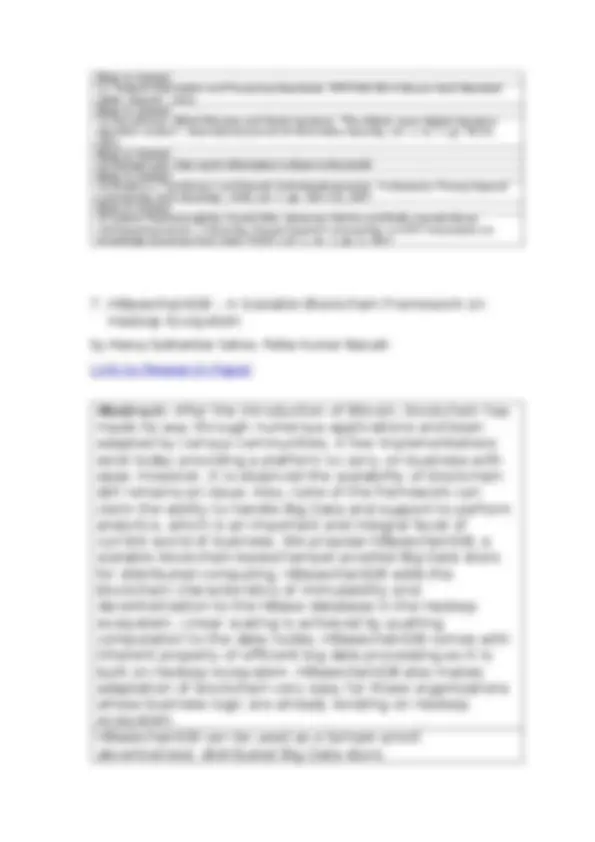
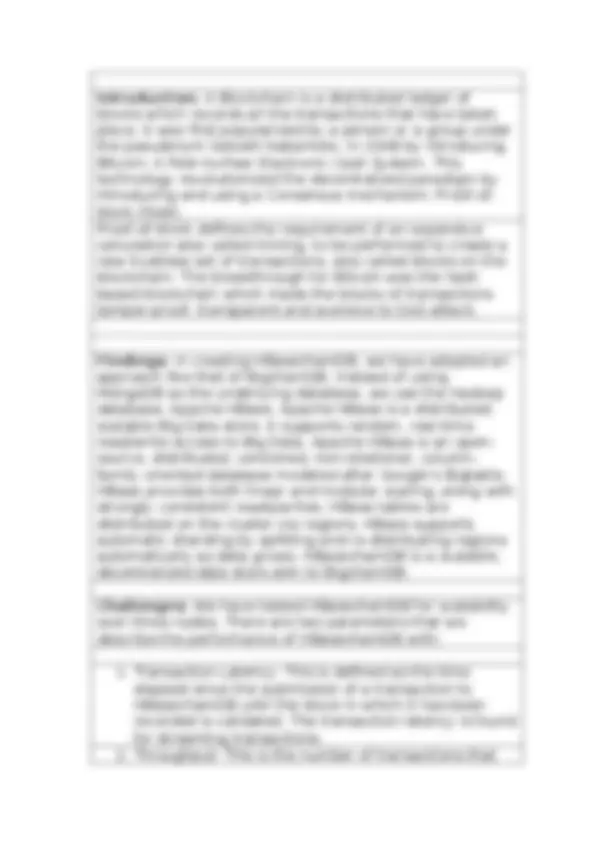
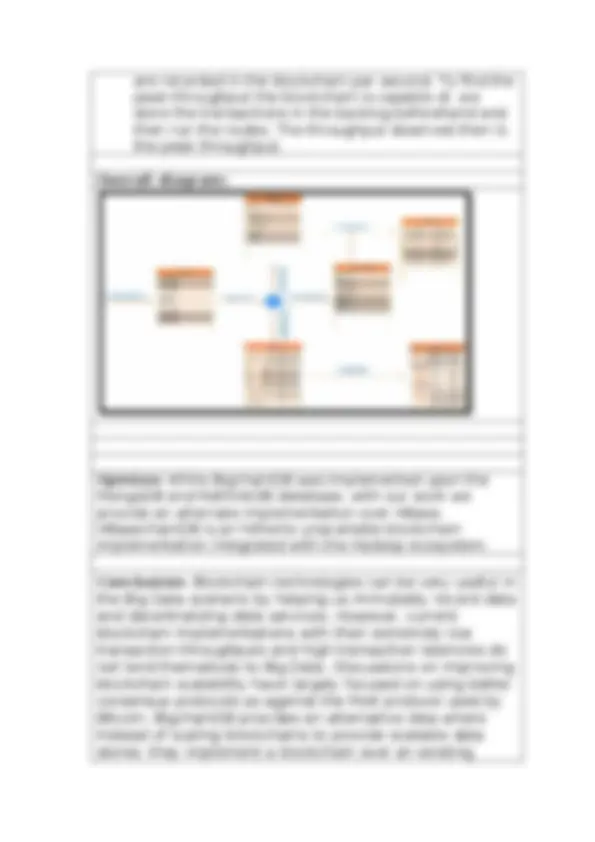
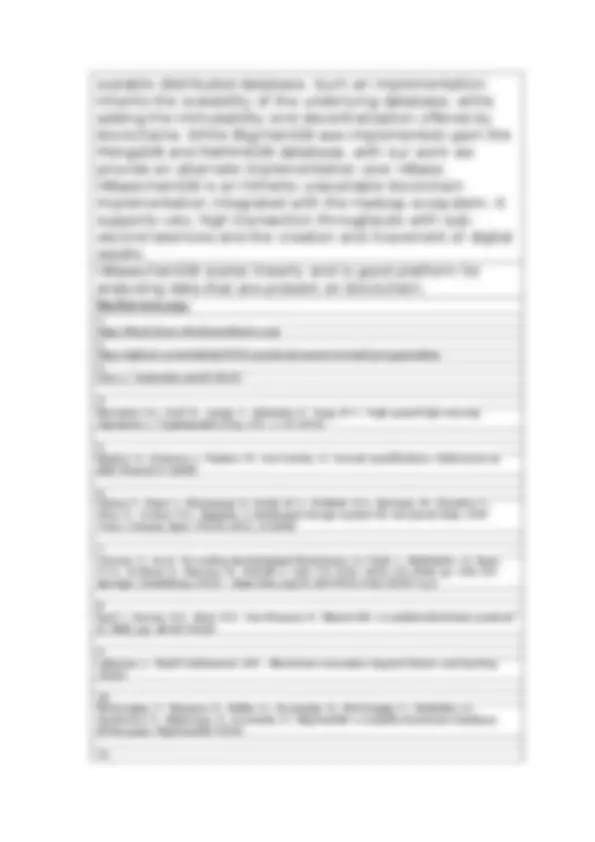
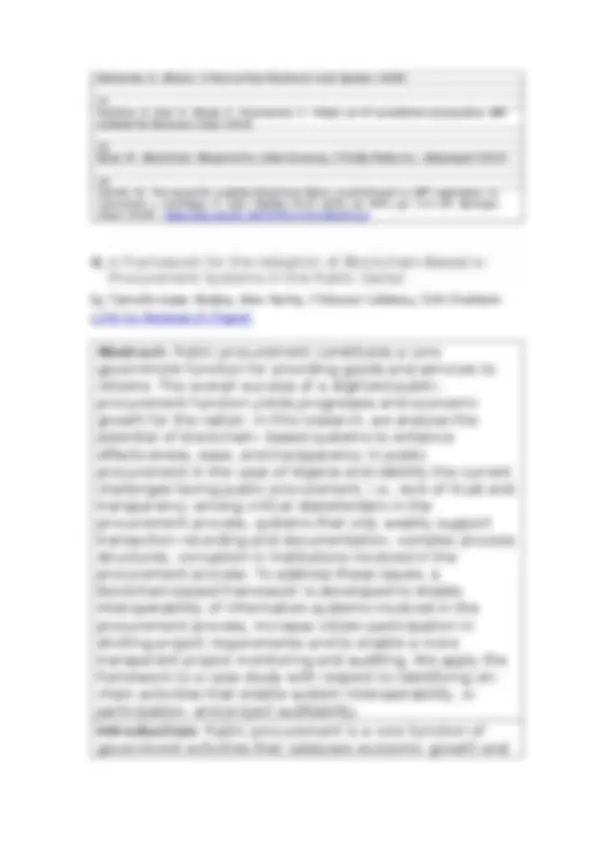

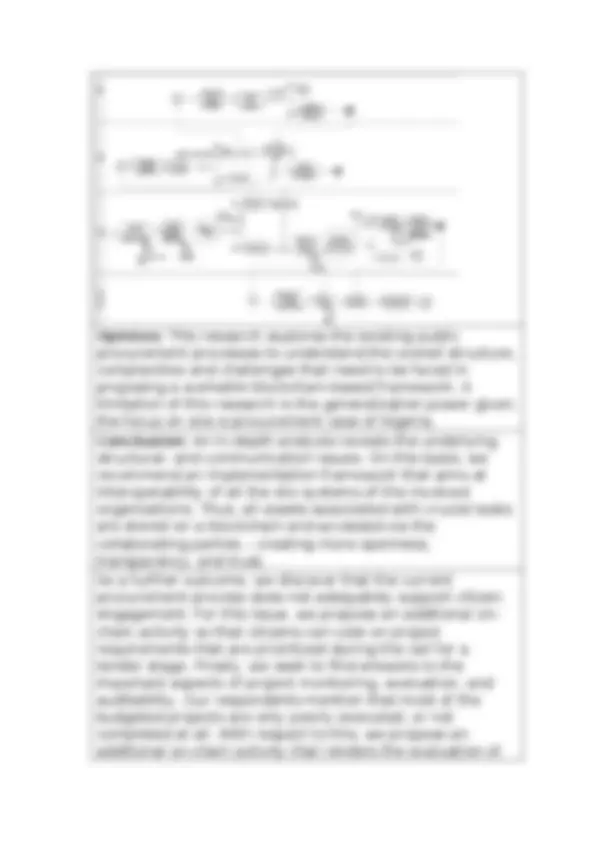
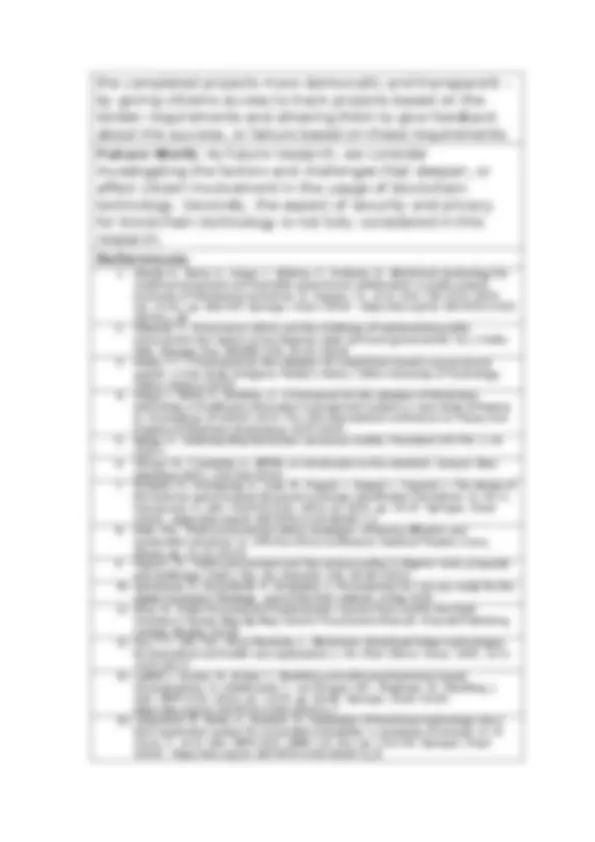
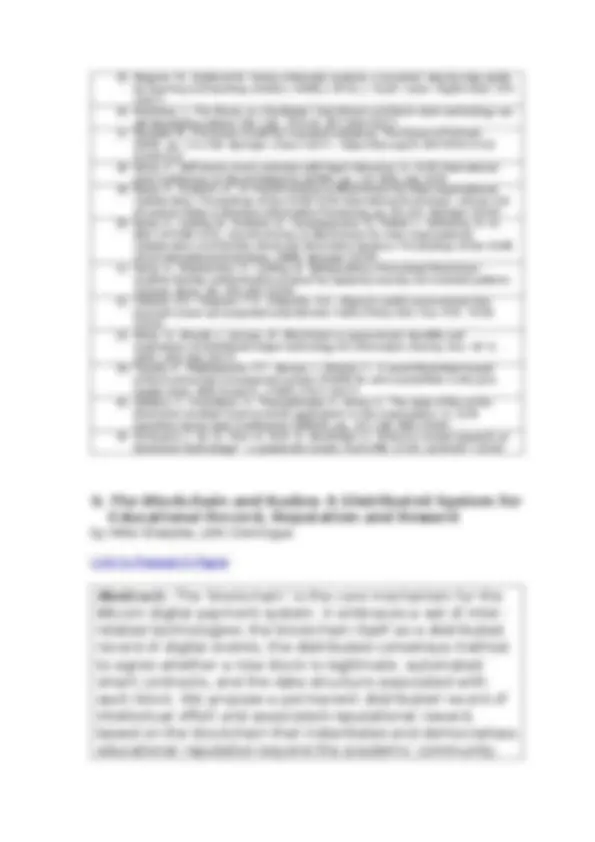
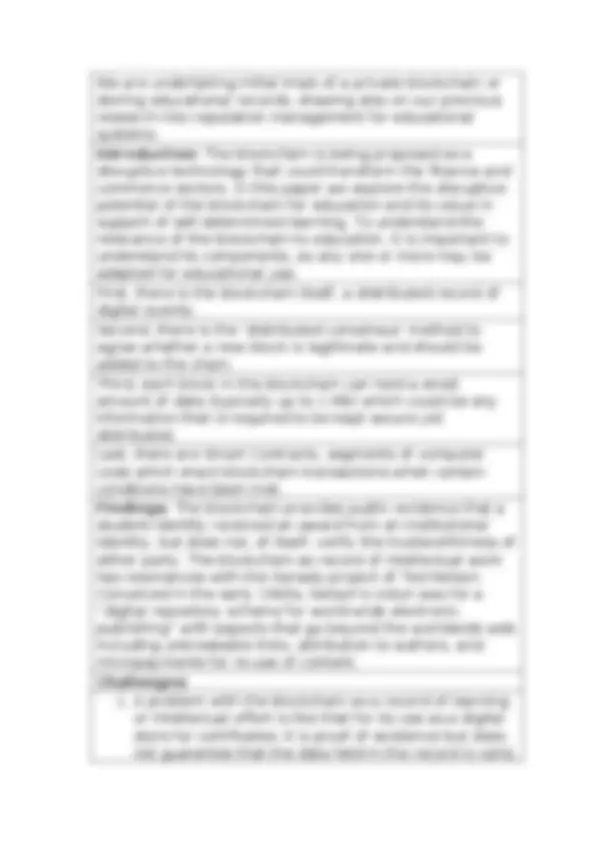
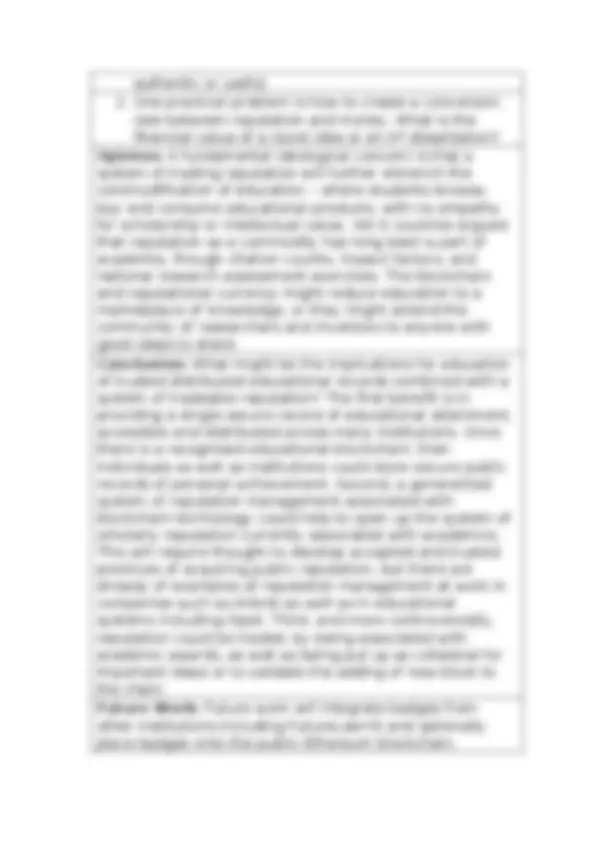
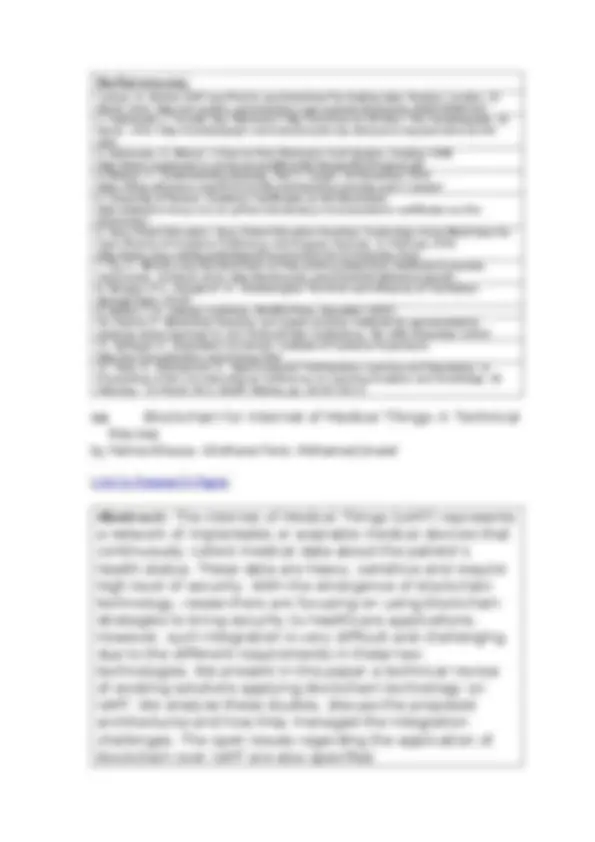
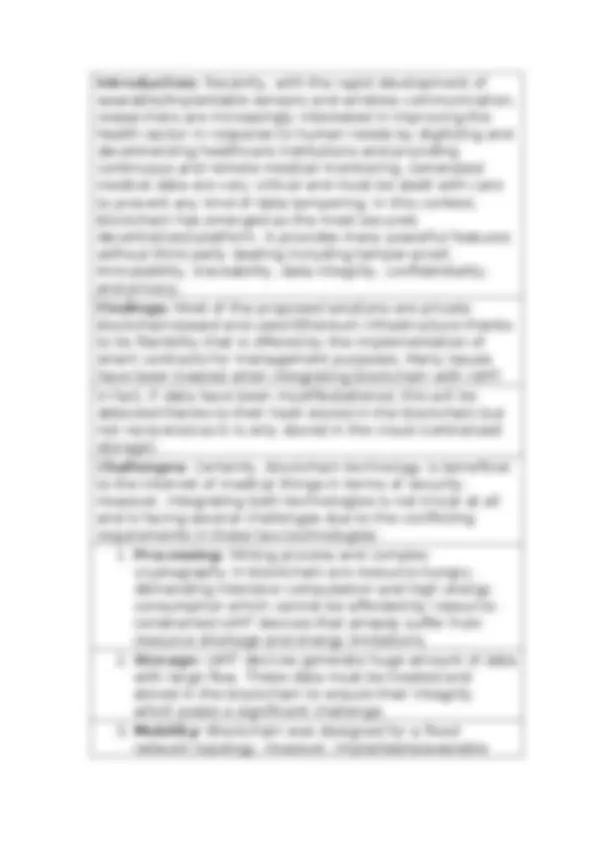
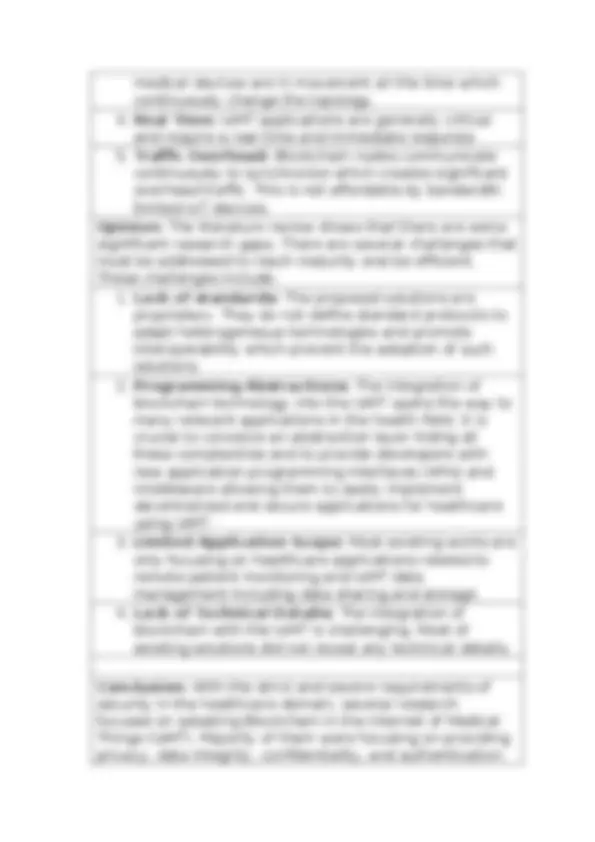
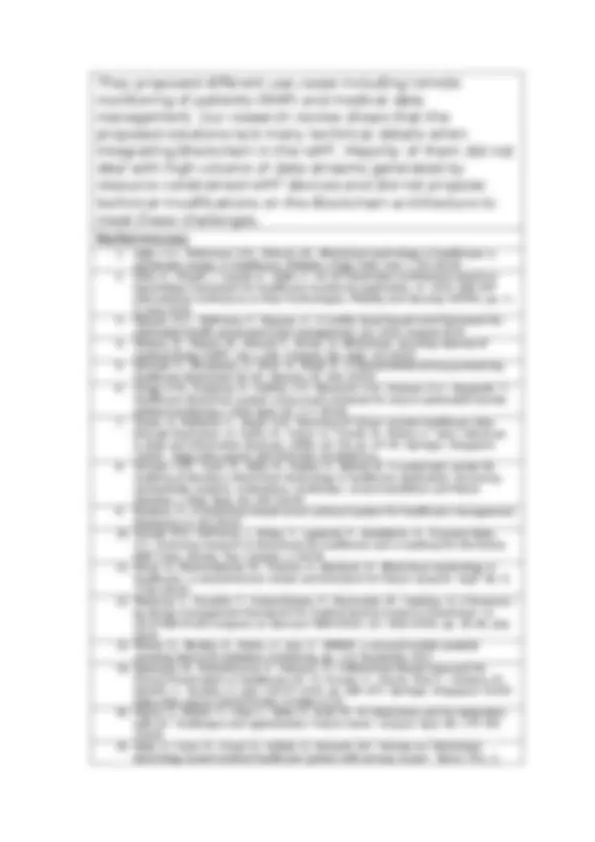
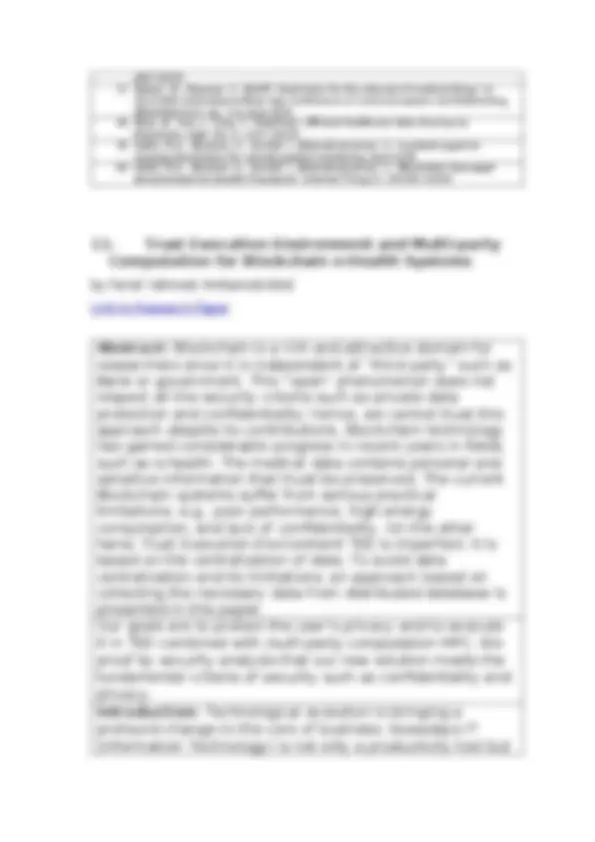
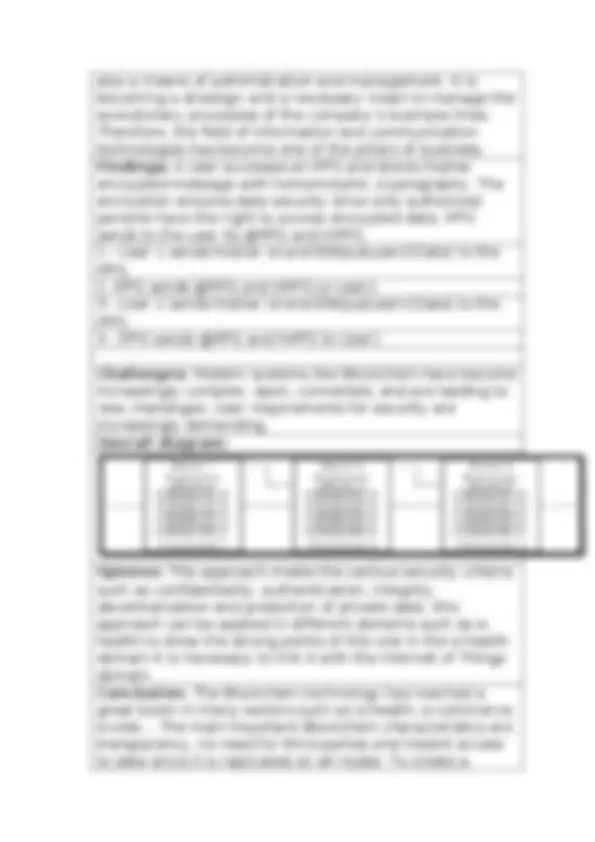

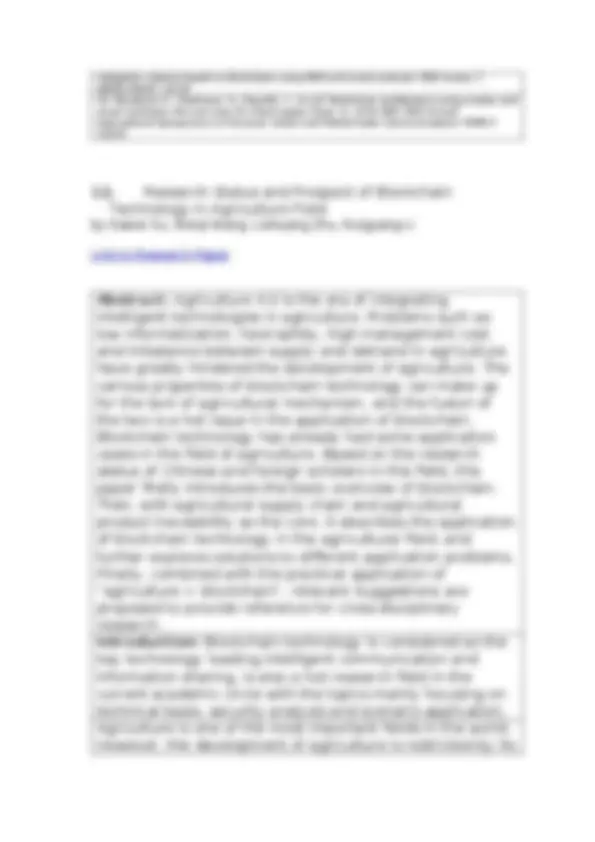
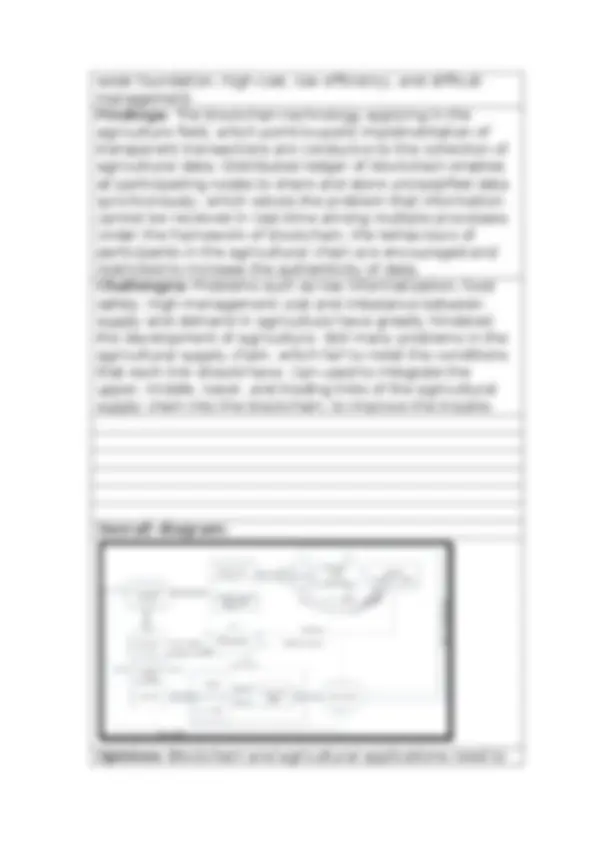
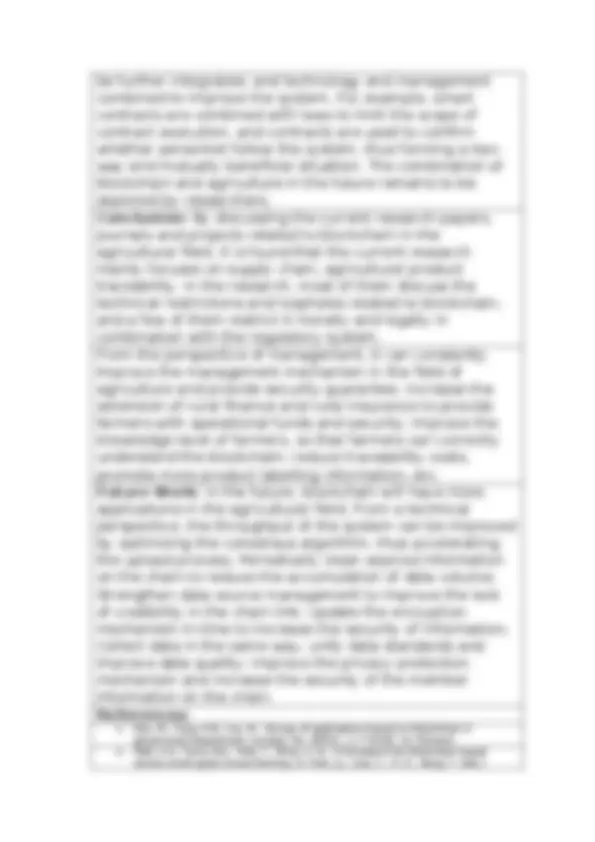
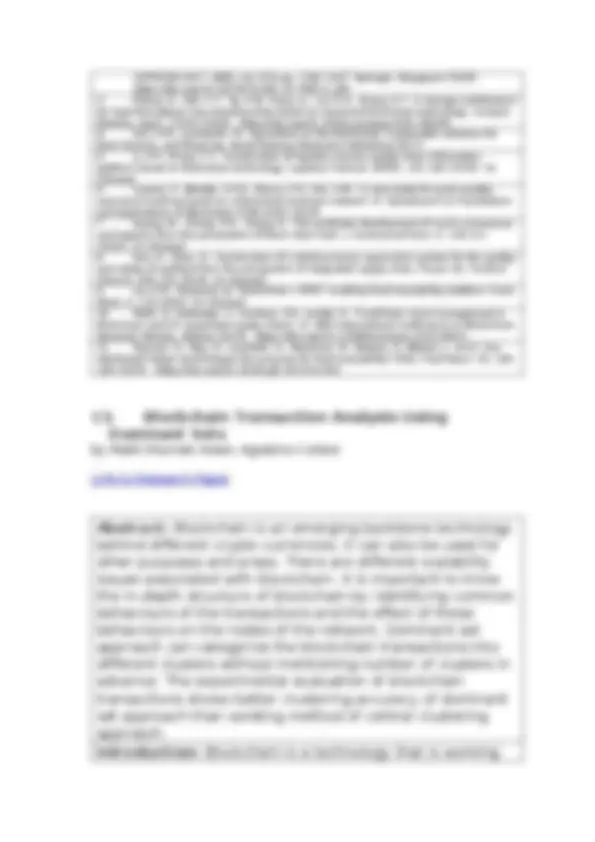
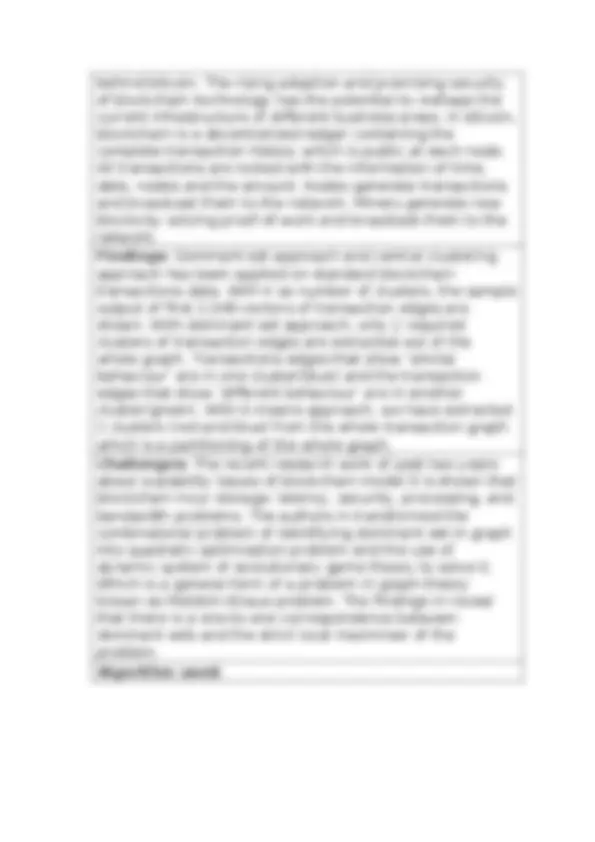

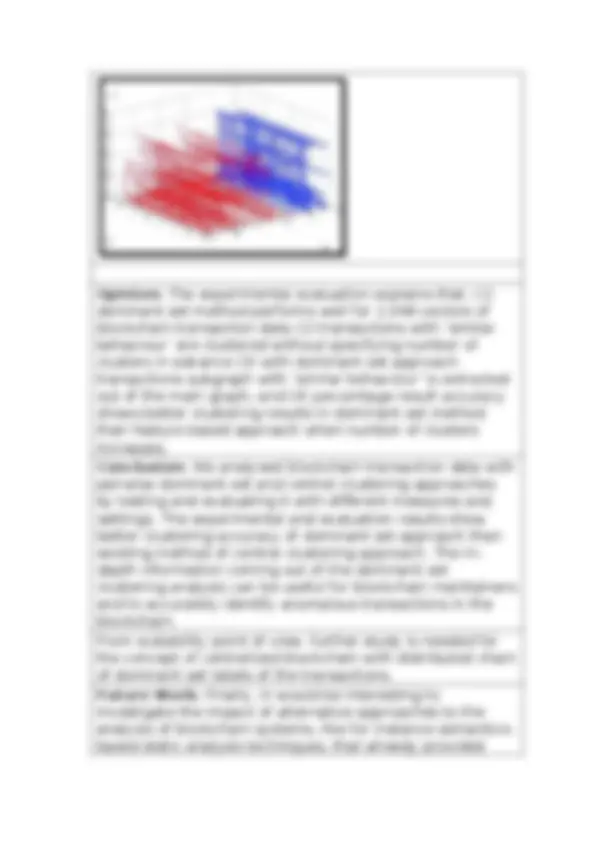
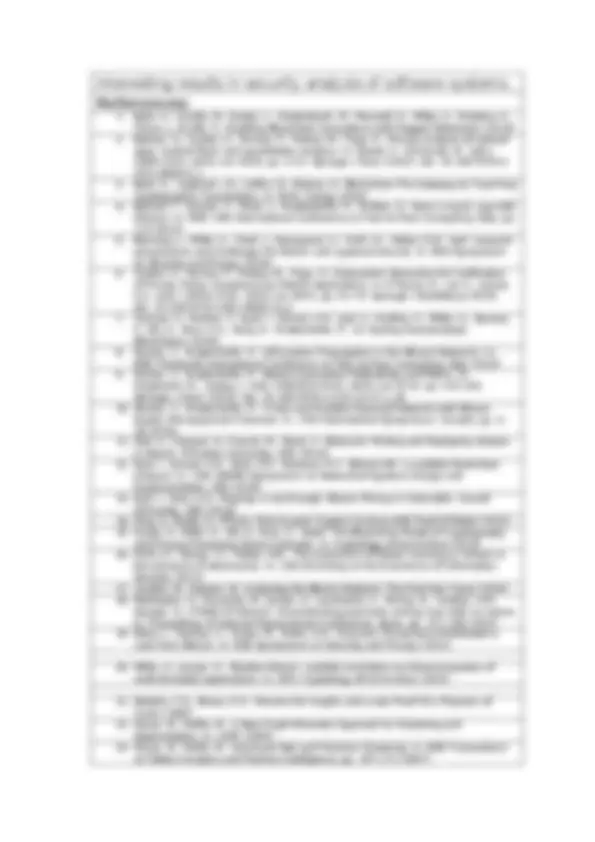
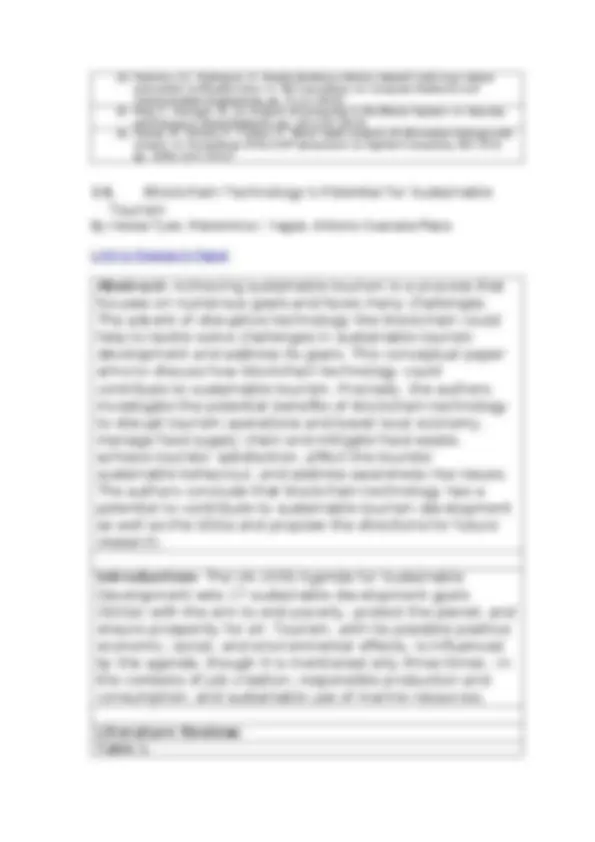
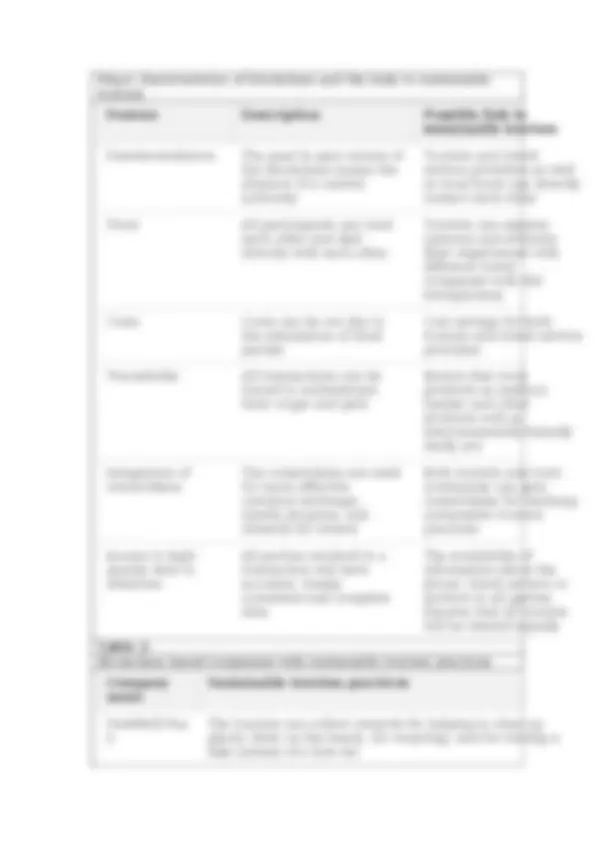
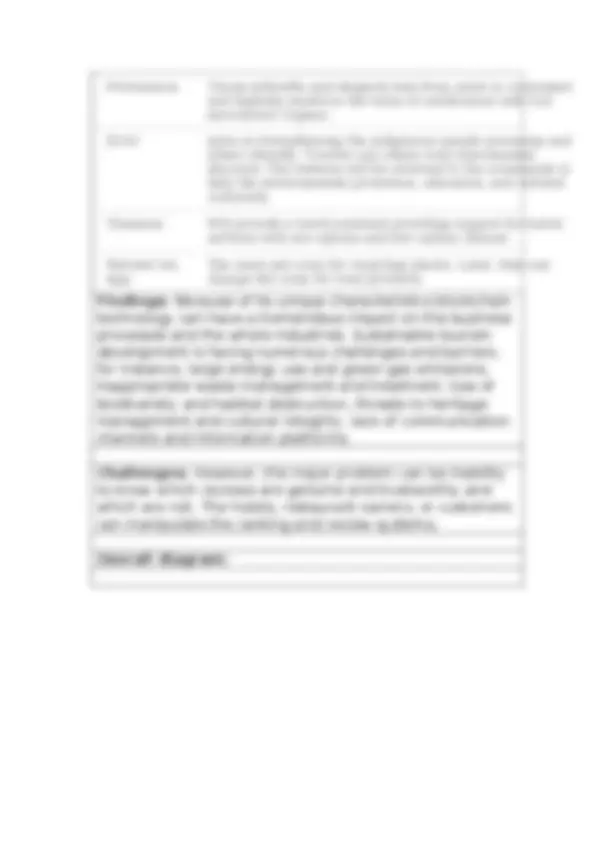
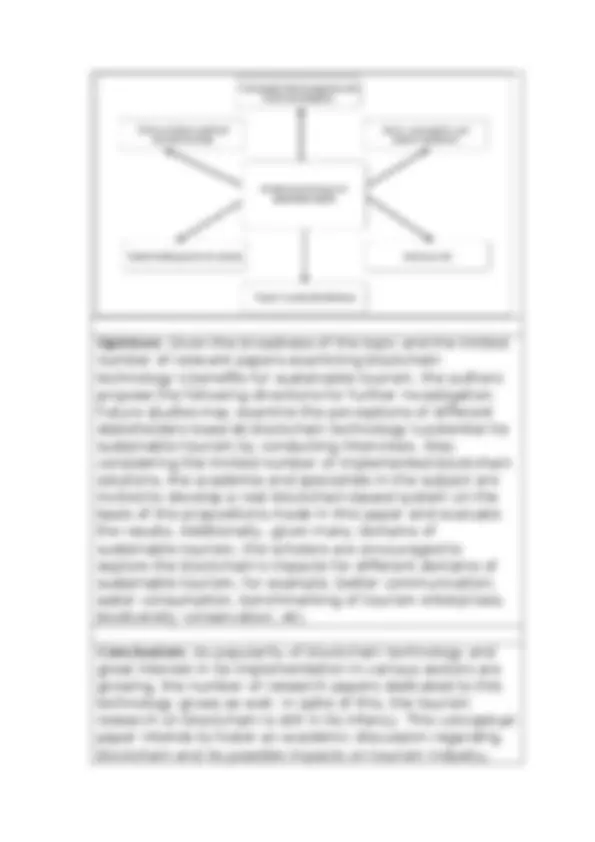
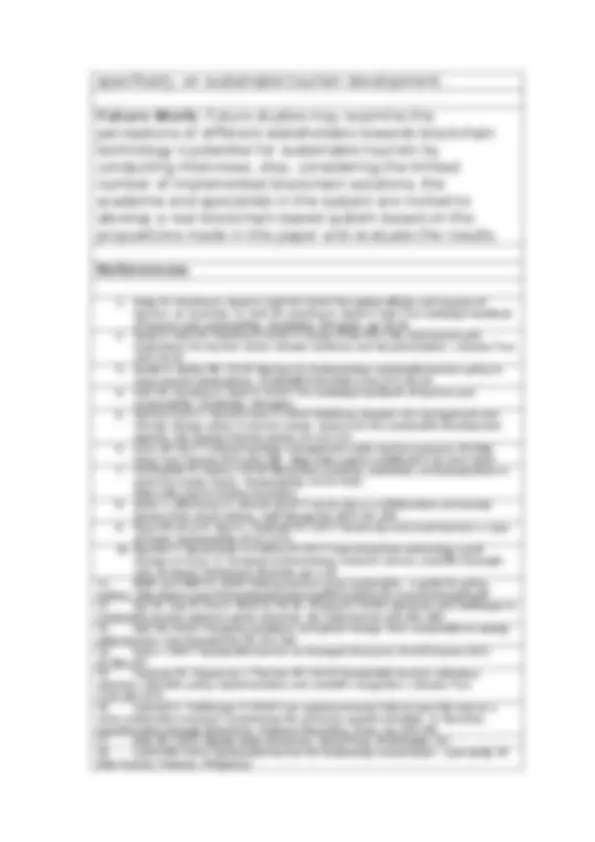
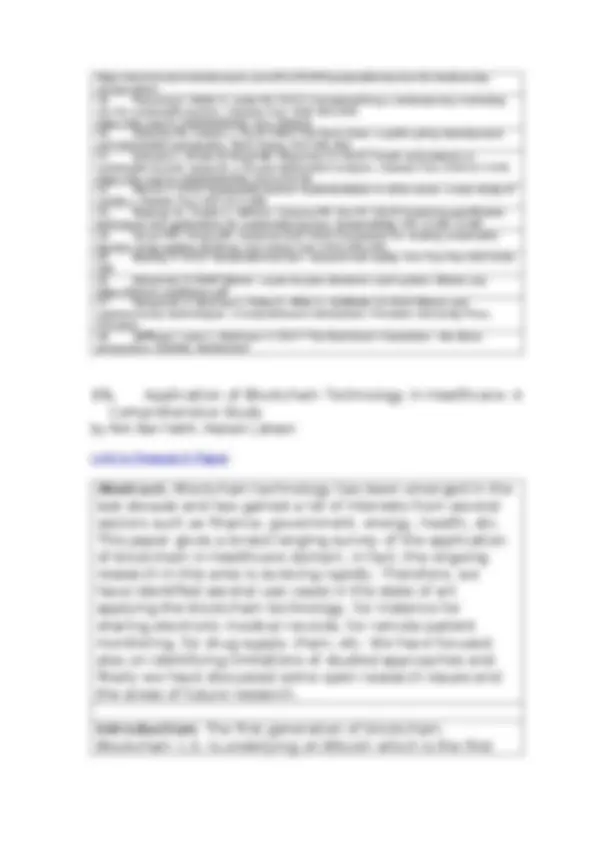
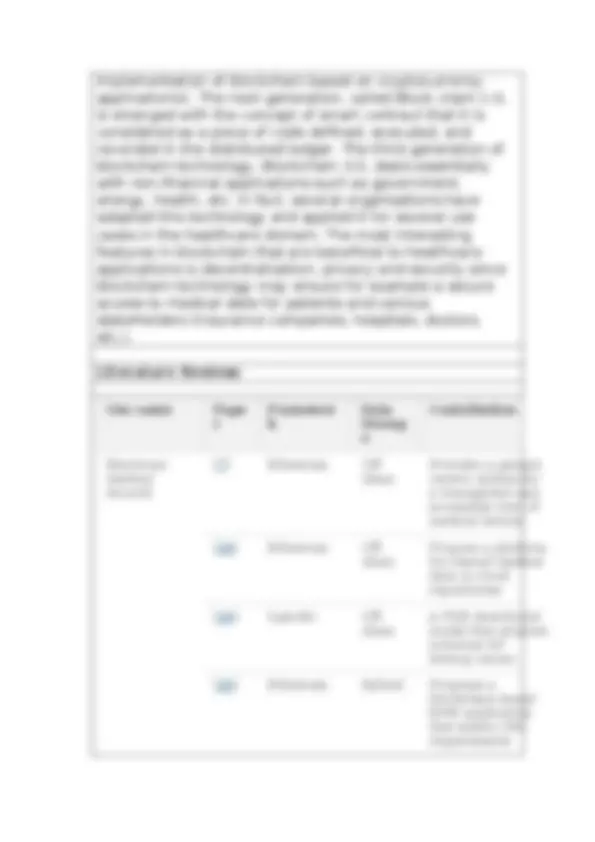

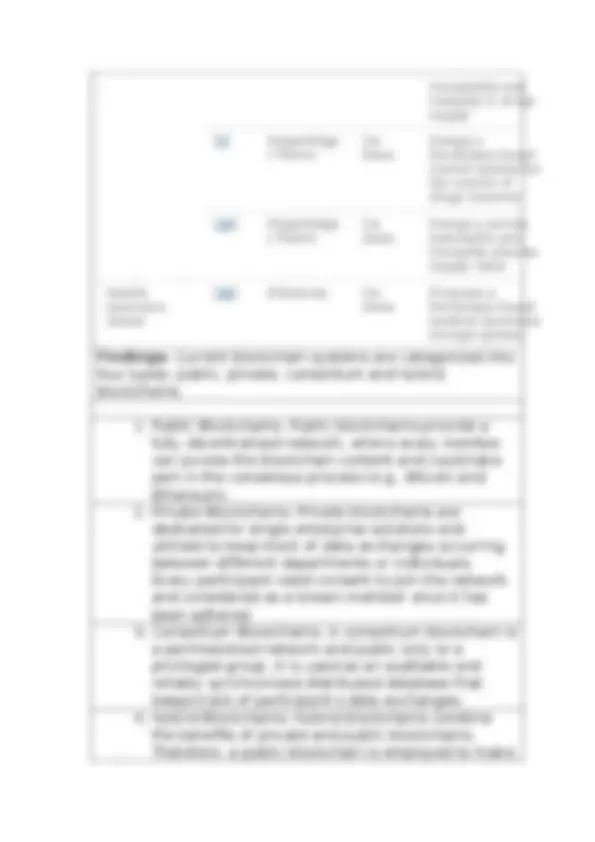
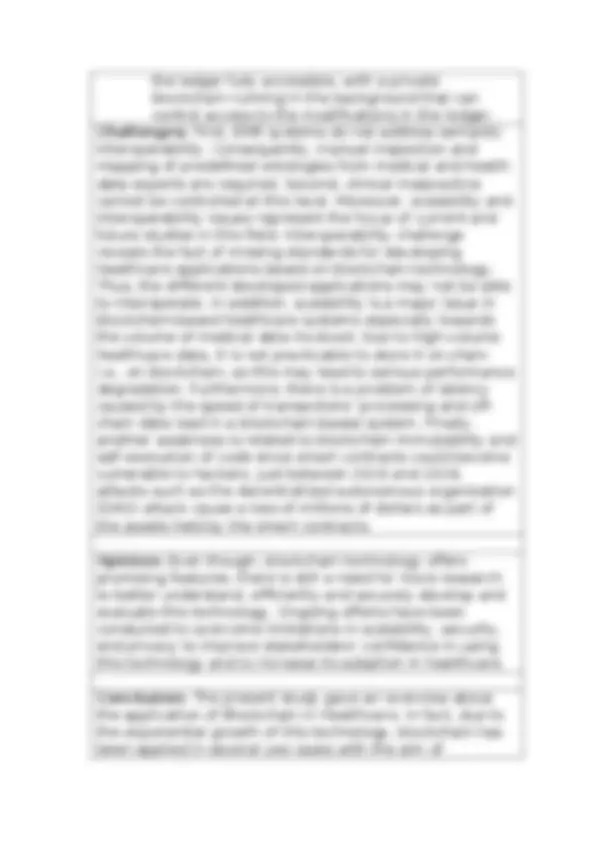
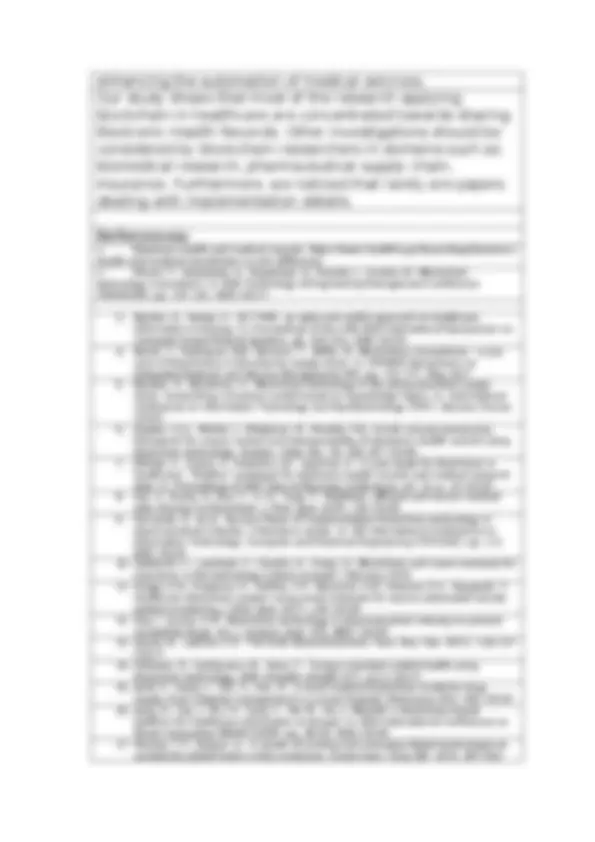
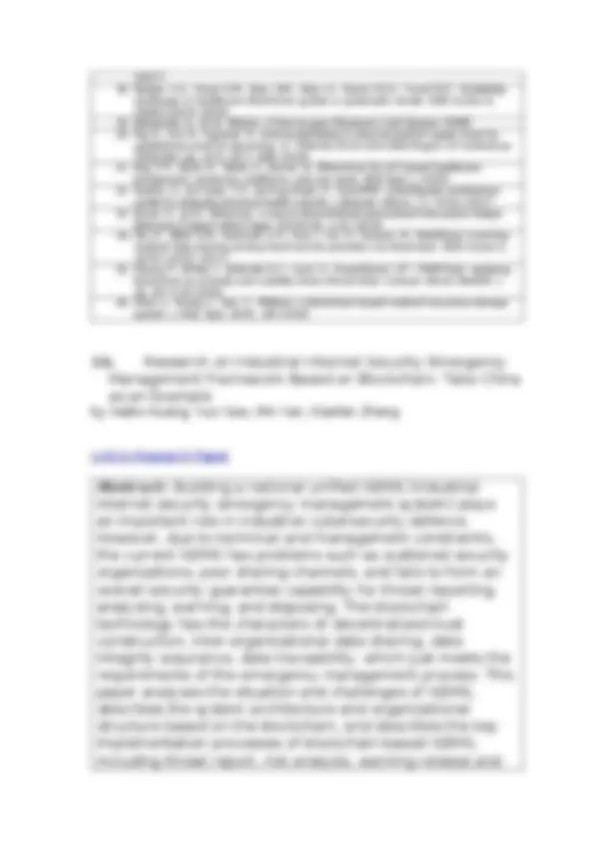

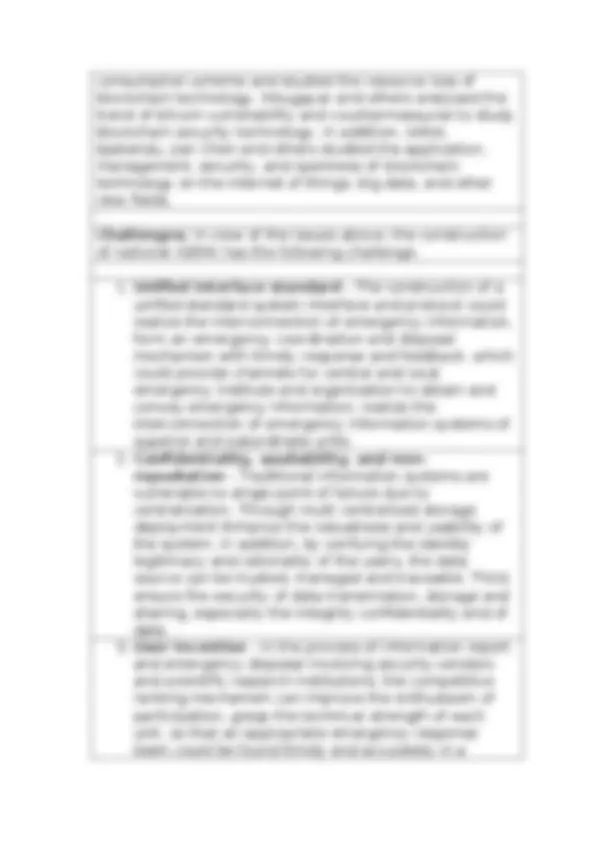

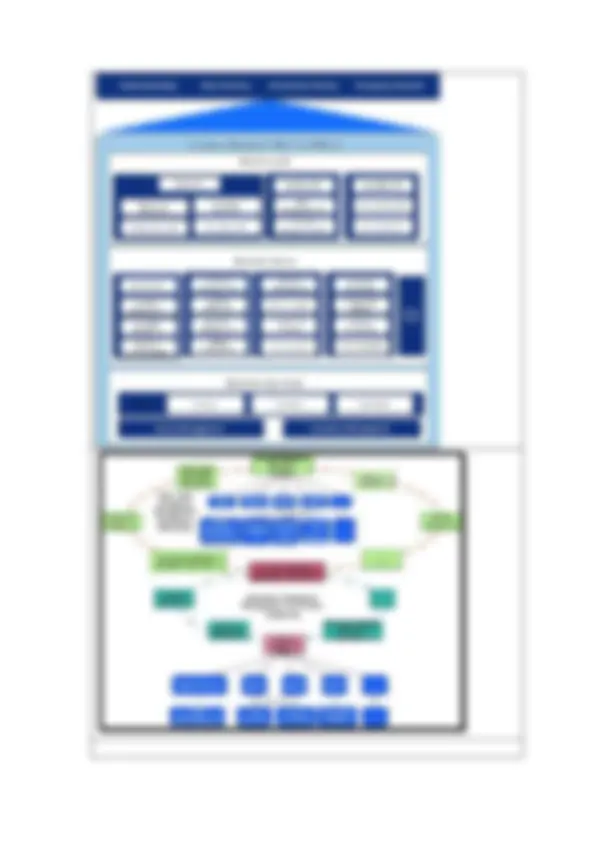
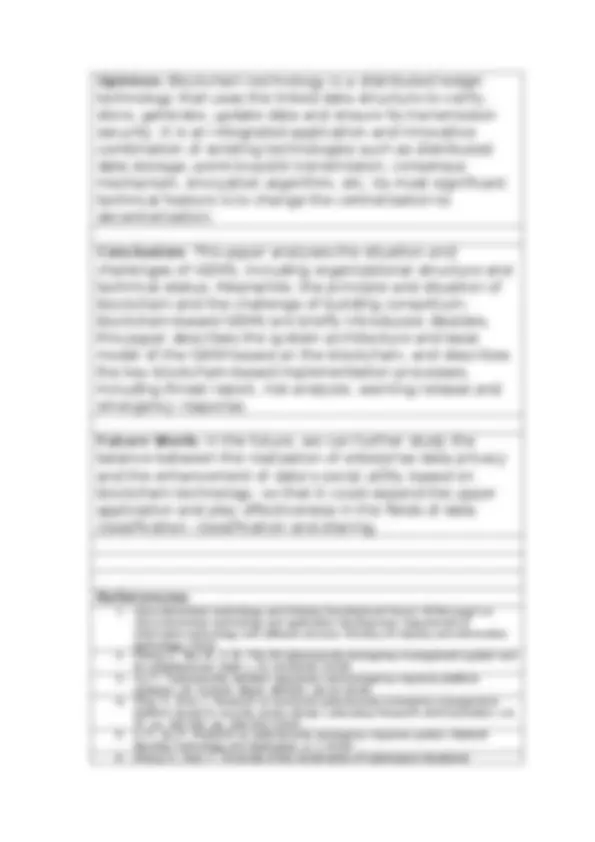
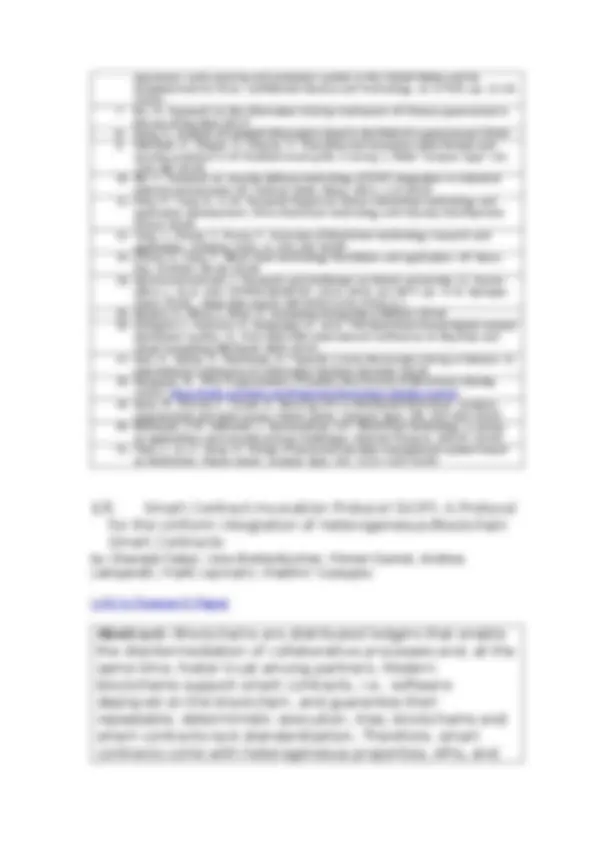
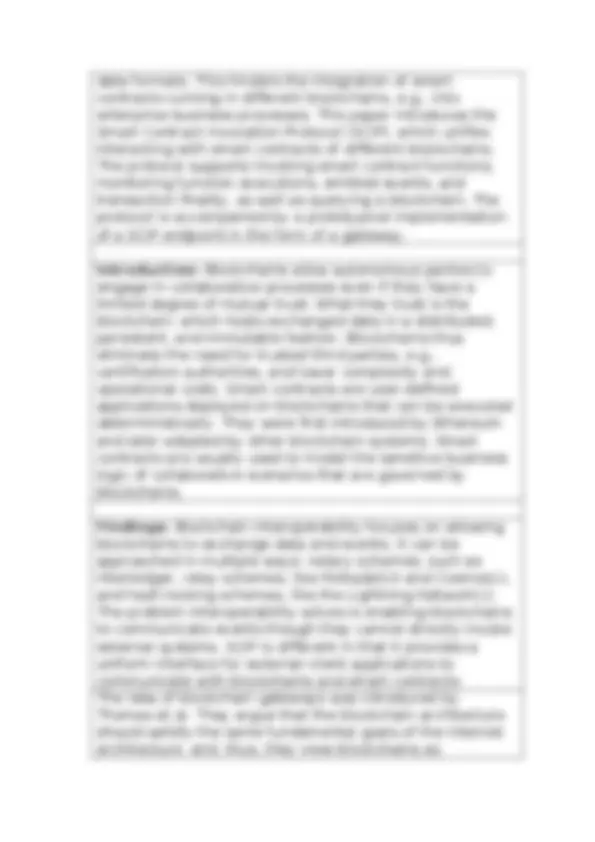
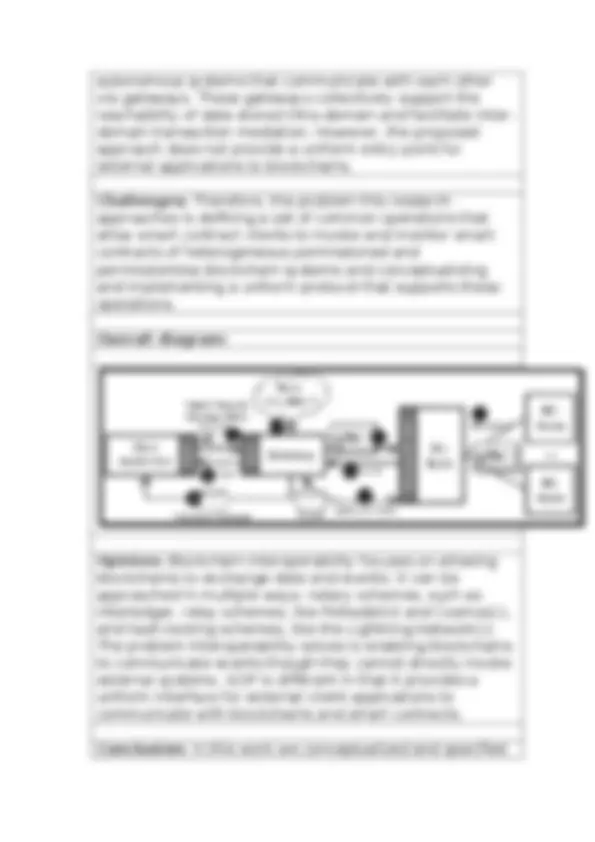
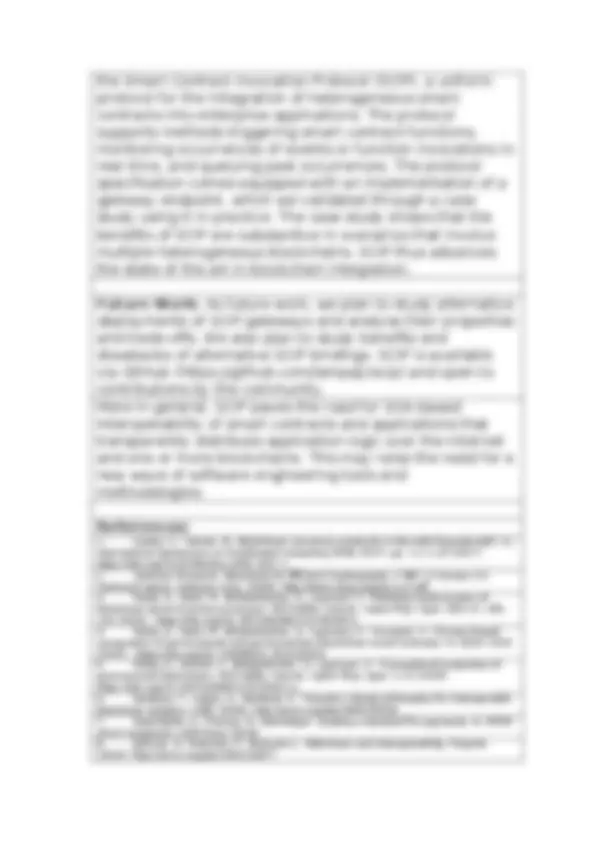
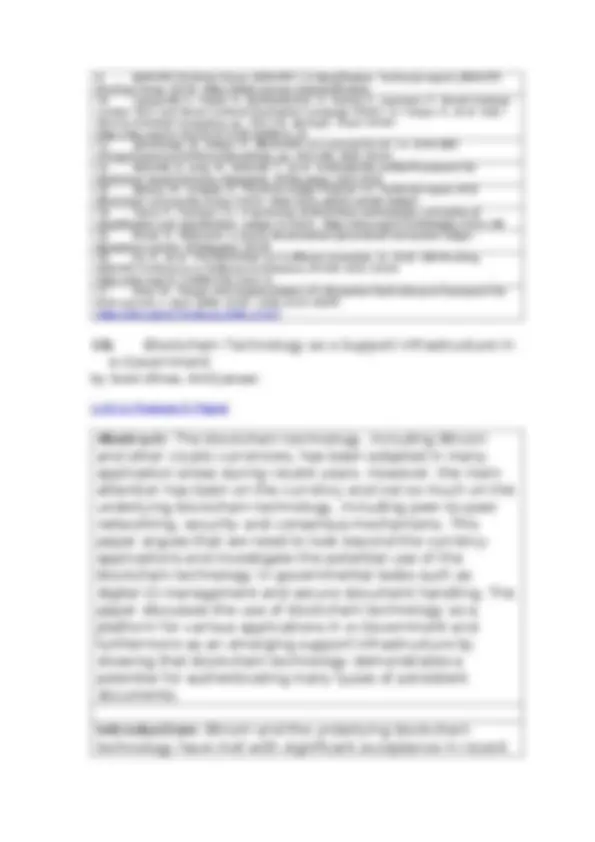
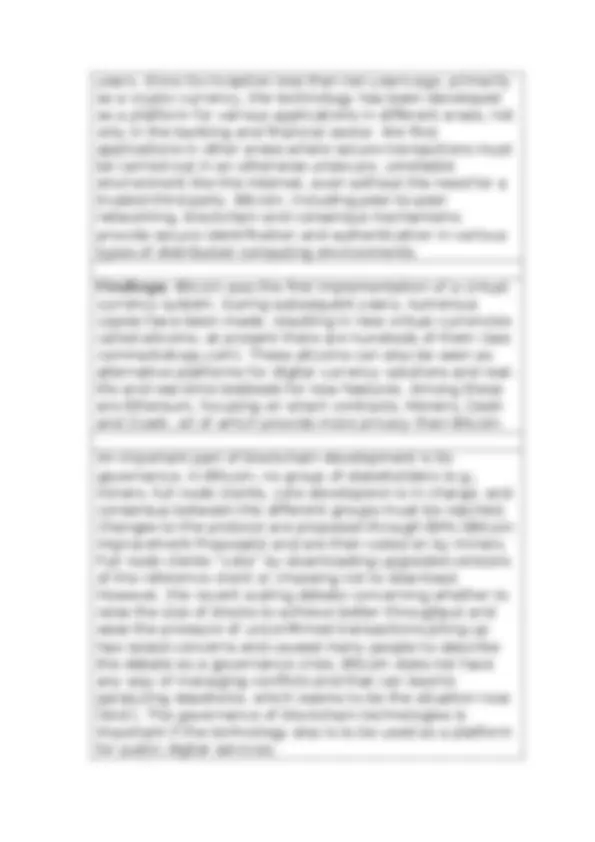
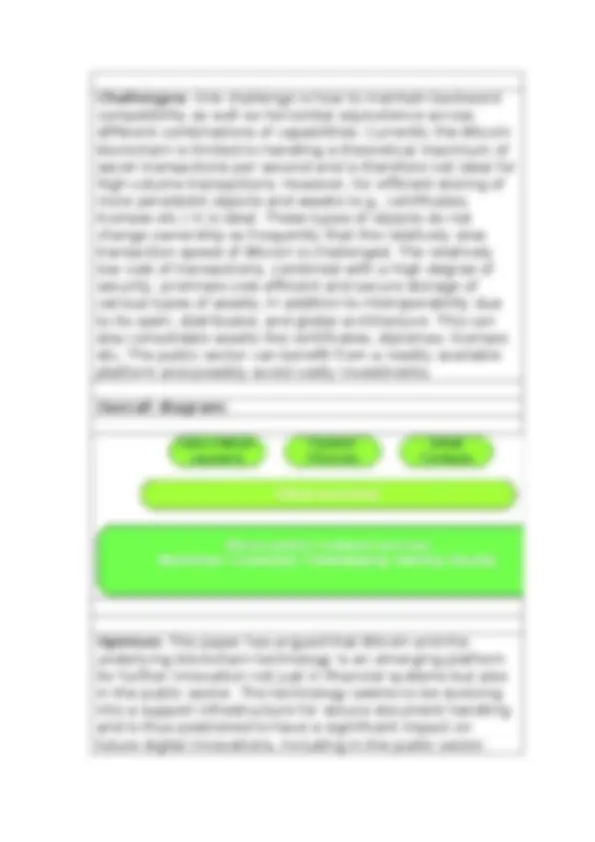
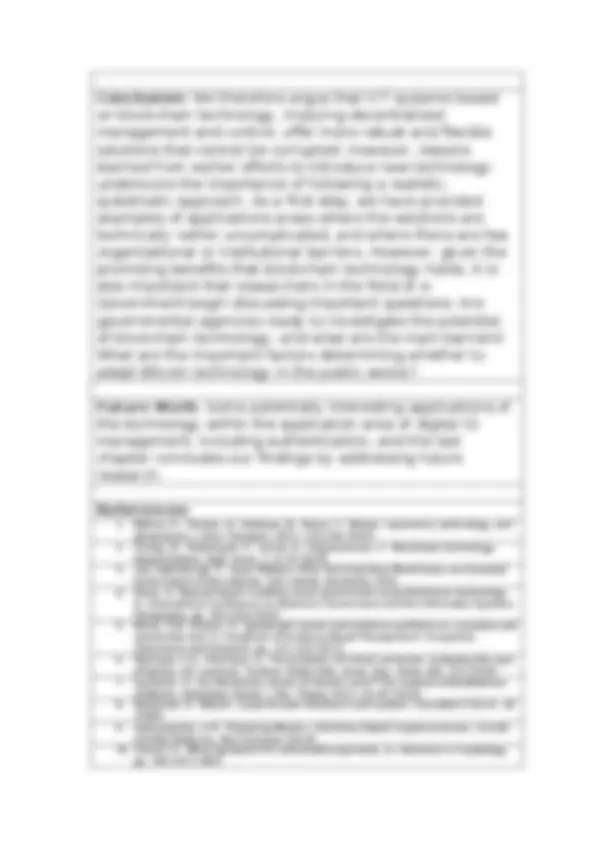
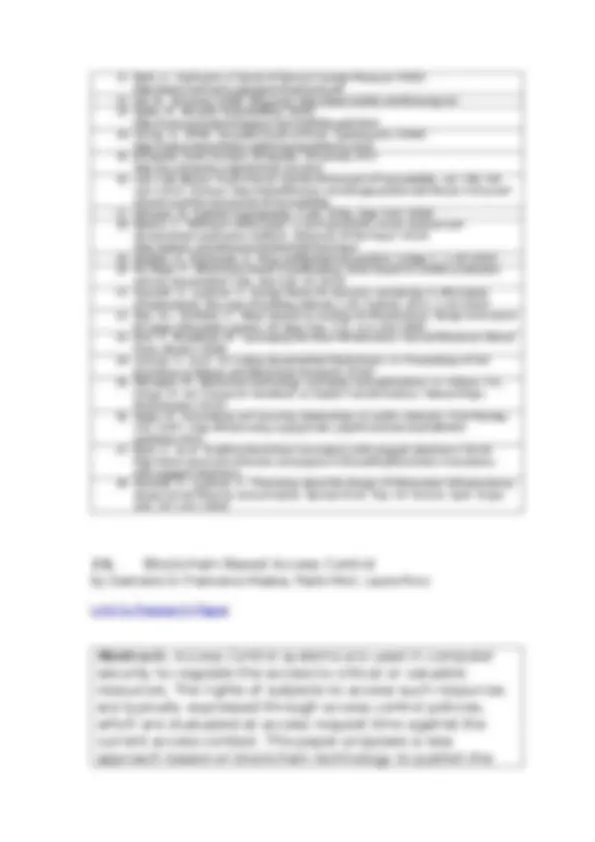
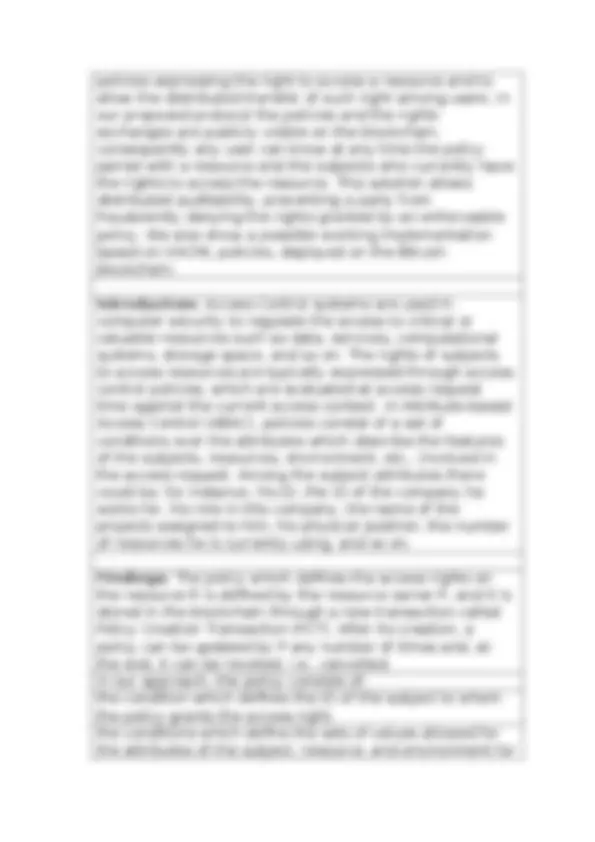
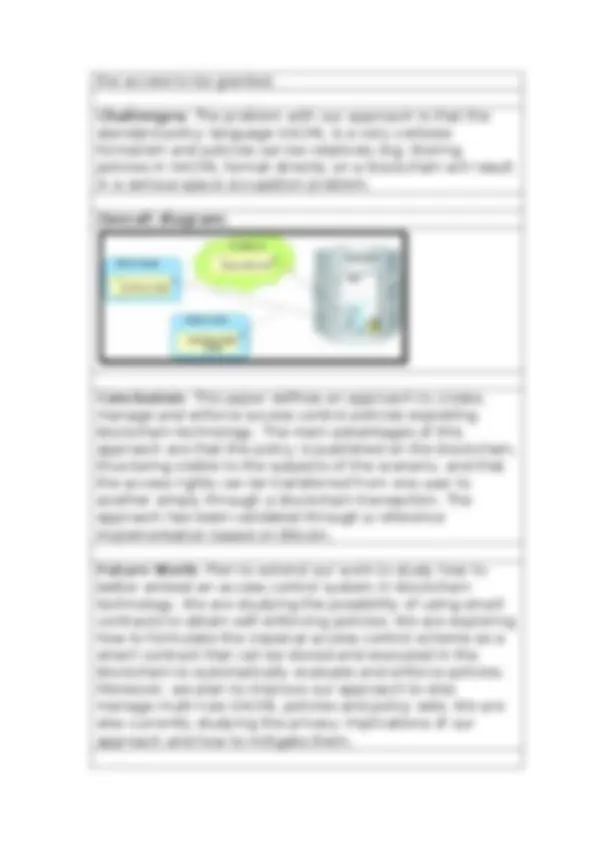
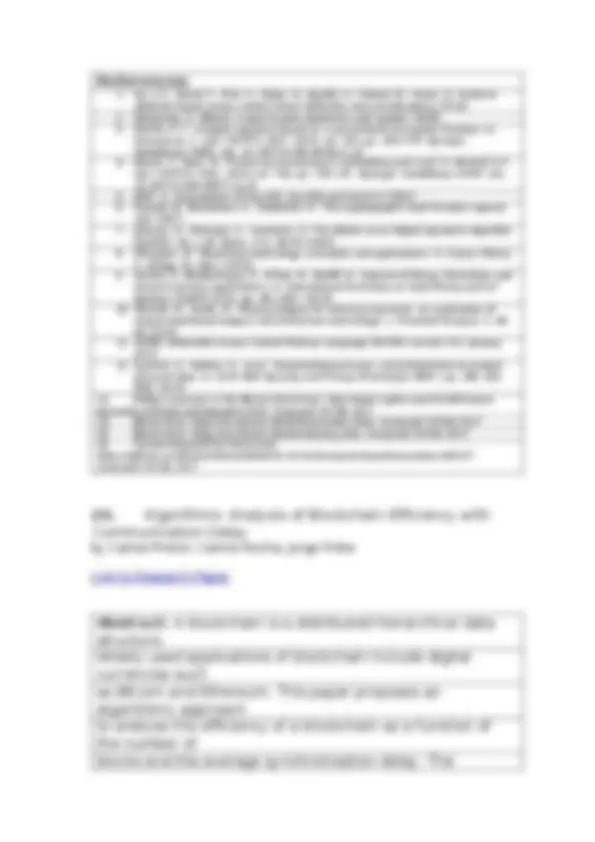
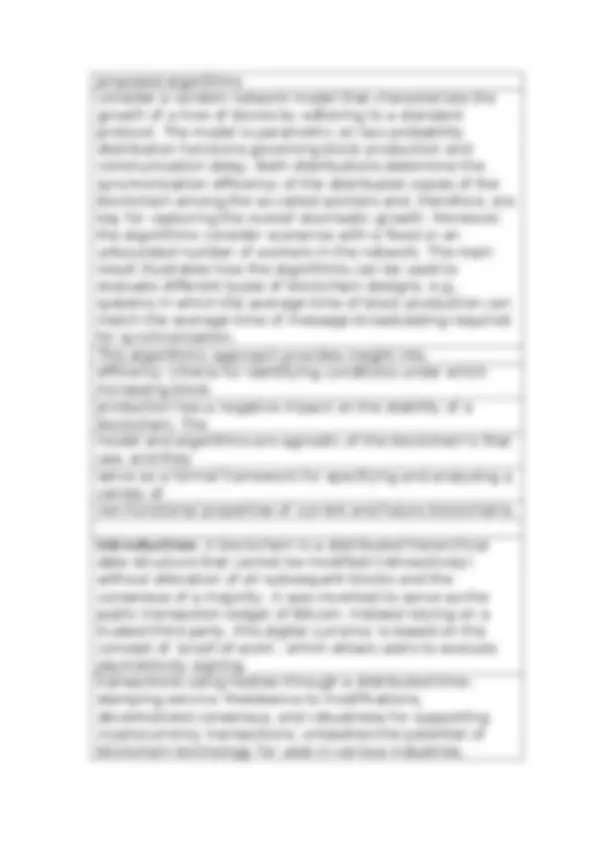
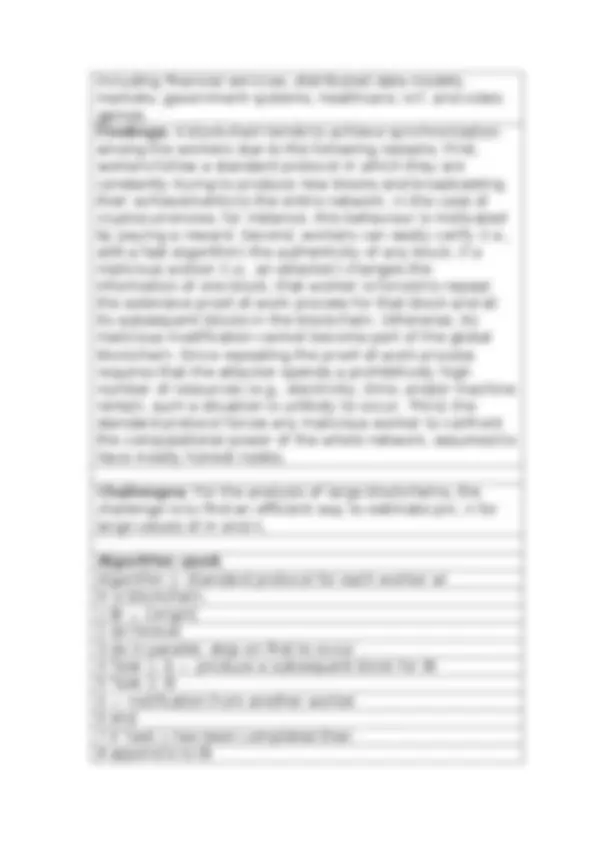
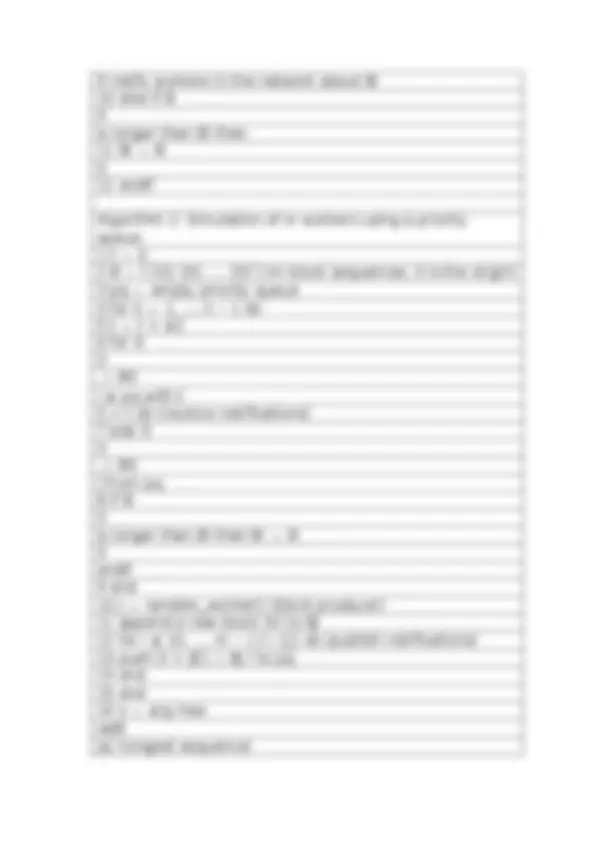
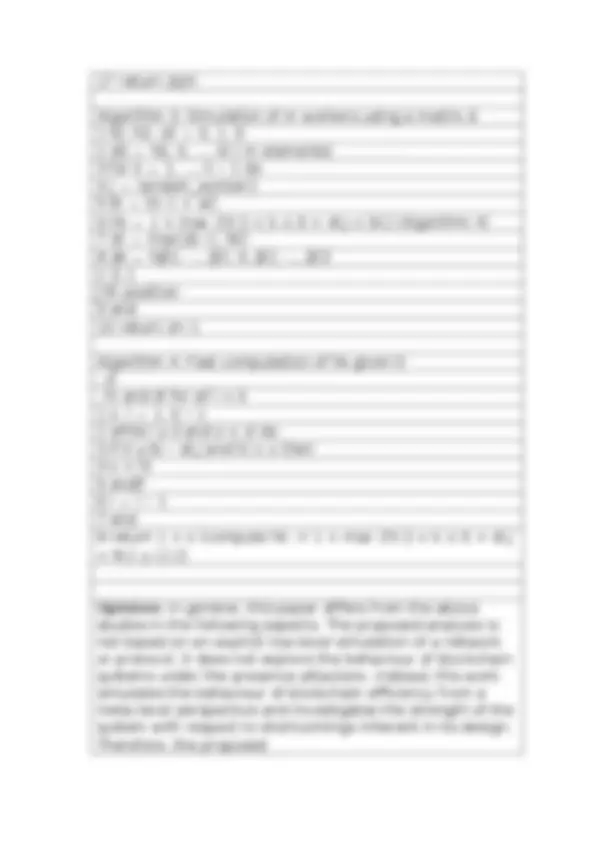
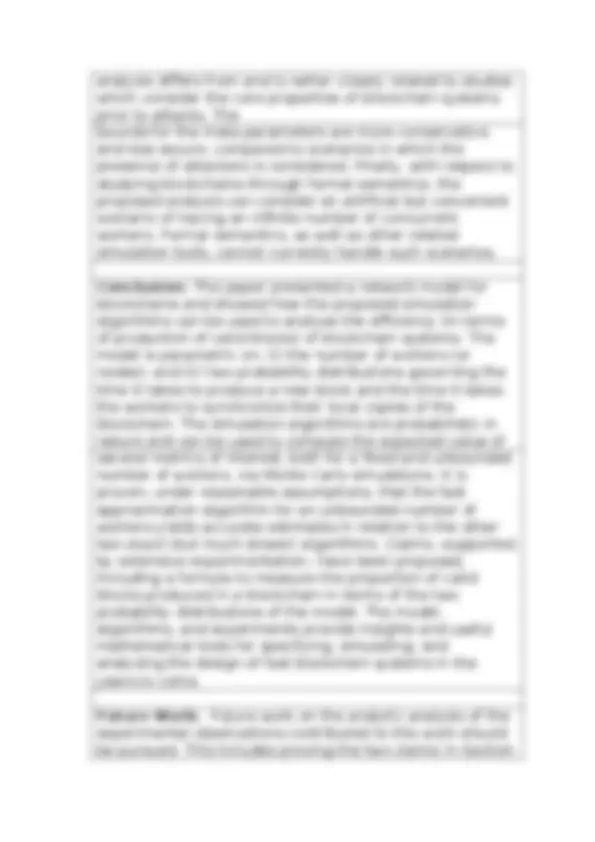
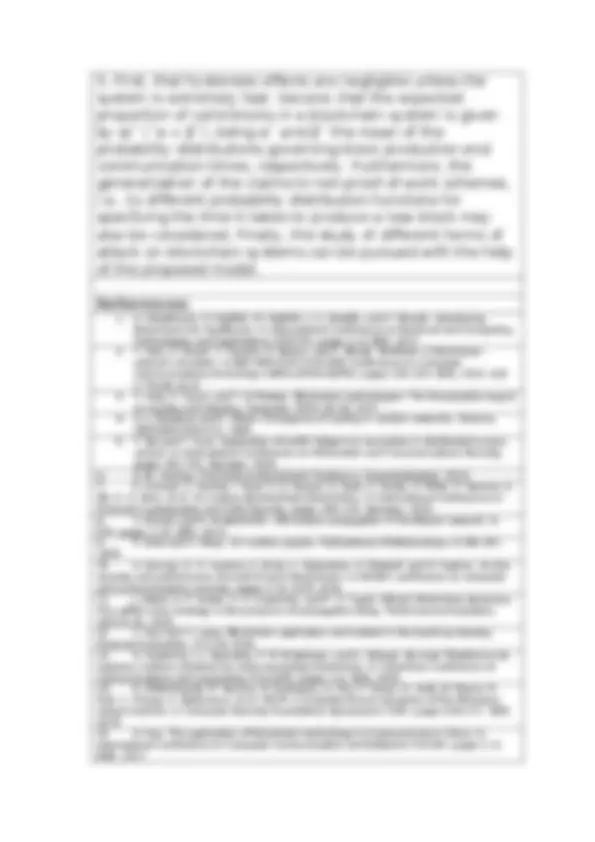
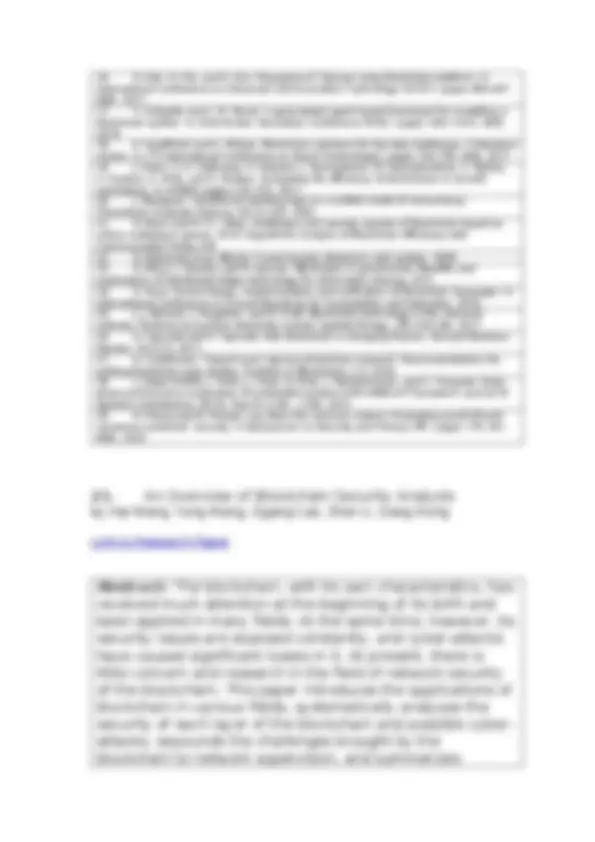
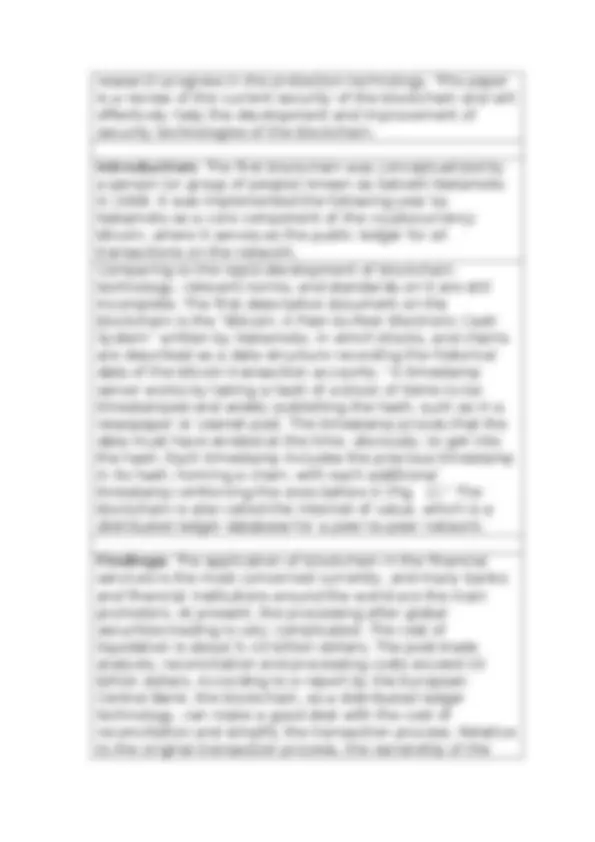
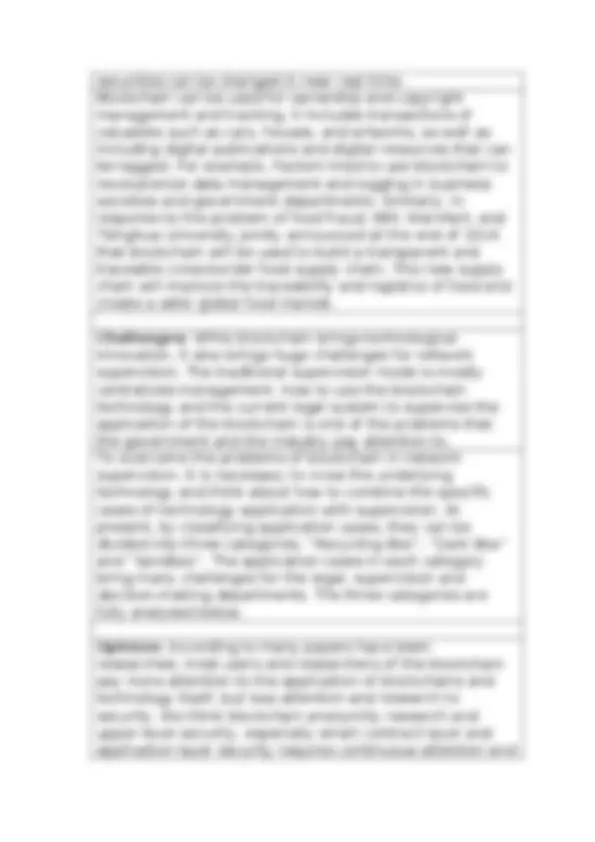
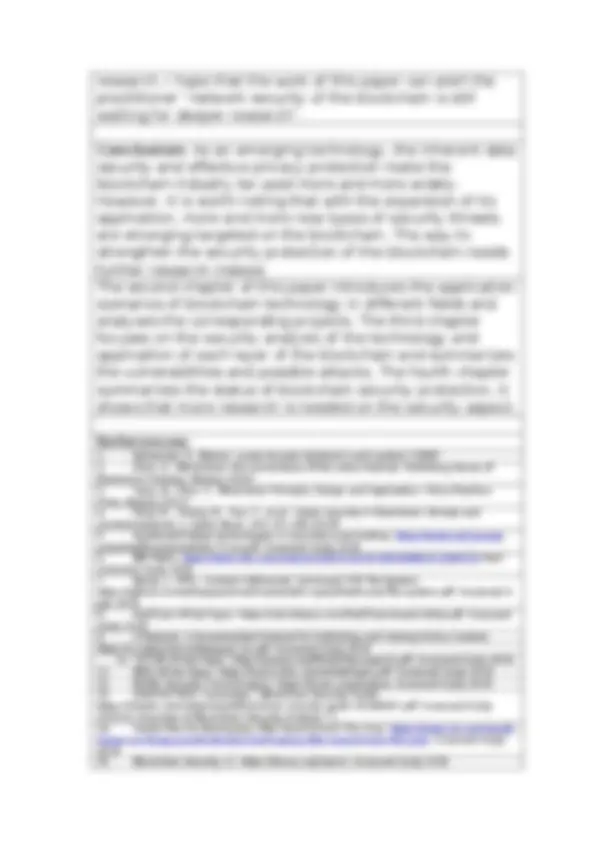
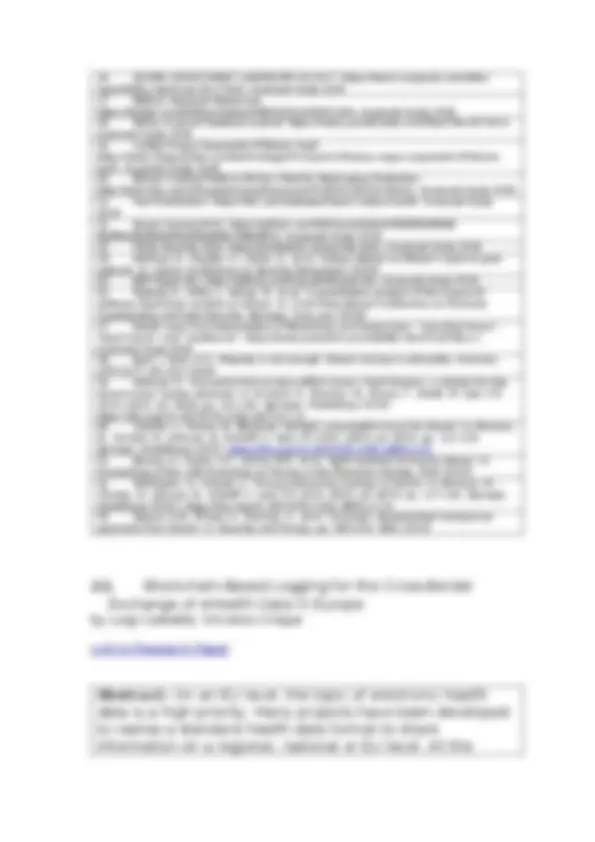
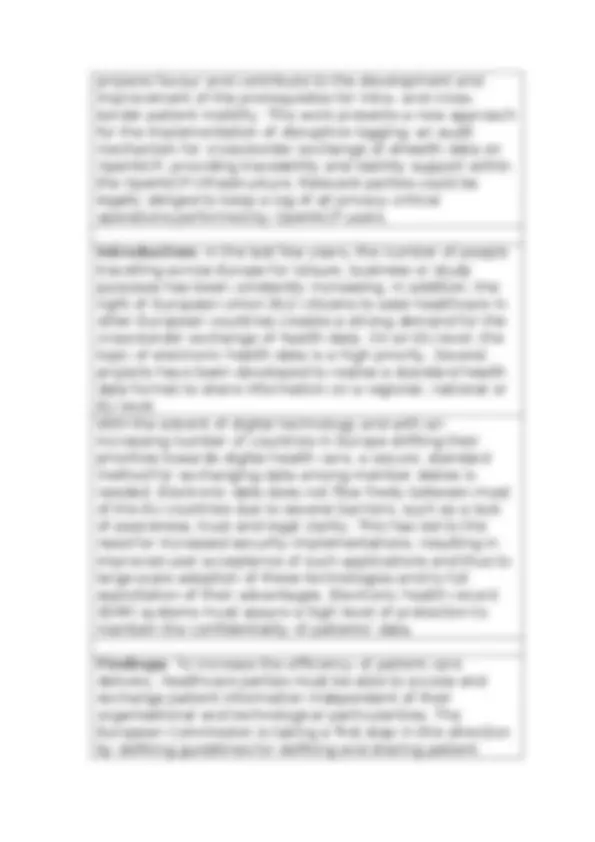
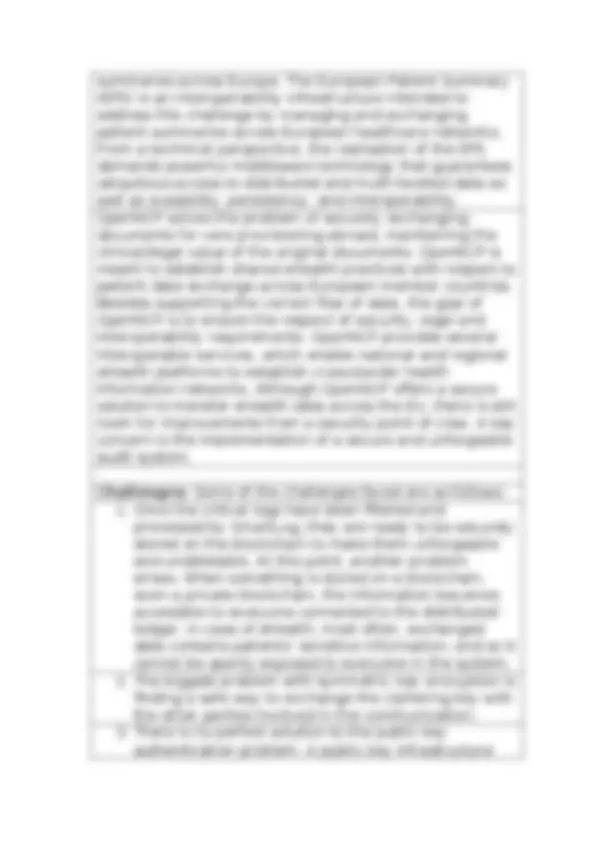
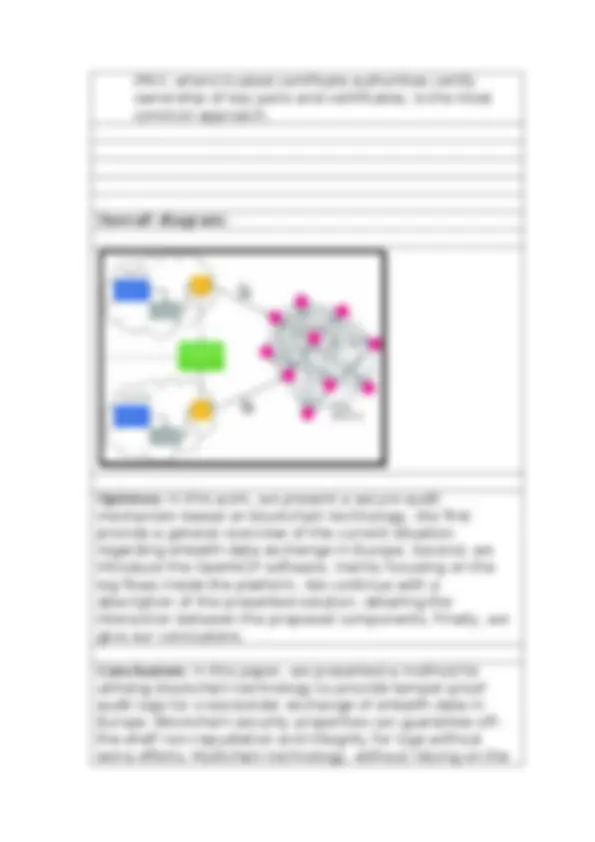
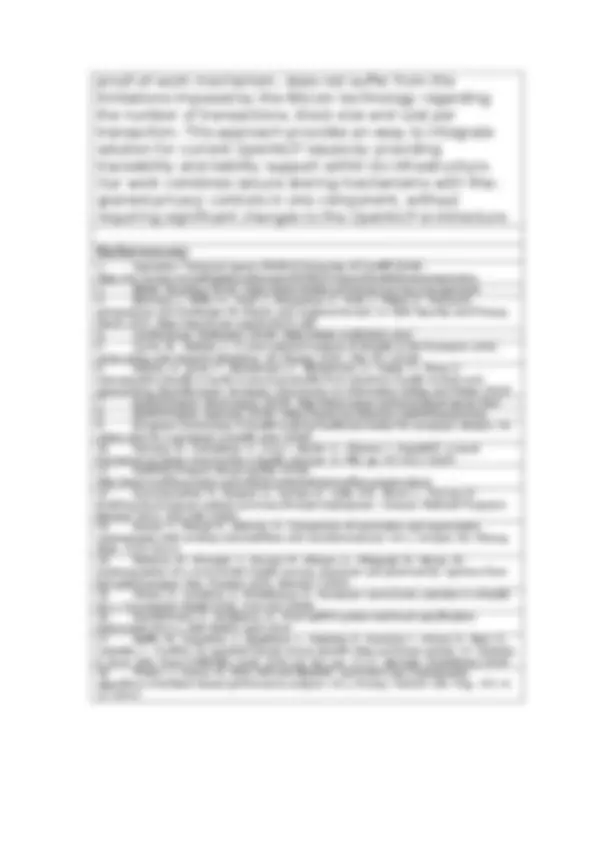
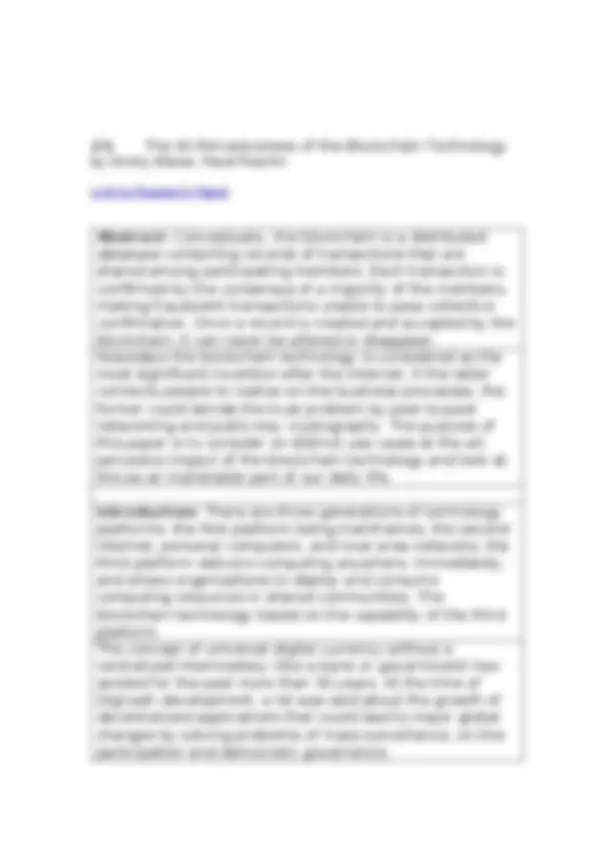


Study with the several resources on Docsity

Earn points by helping other students or get them with a premium plan


Prepare for your exams
Study with the several resources on Docsity

Earn points to download
Earn points by helping other students or get them with a premium plan
Community
Ask the community for help and clear up your study doubts
Discover the best universities in your country according to Docsity users
Free resources
Download our free guides on studying techniques, anxiety management strategies, and thesis advice from Docsity tutors
BLOCKCHAIN AND CRYPTOCURRENCIES DIGITAL ASSIGNMENT Blockchain is considered by many to be a disruptive core technology. Although many researchers have realized the importance of blockchain, the research of blockchain is still in its infancy. Consequently, this study reviews the current academic research on blockchain, especially in the subject area of business and economics. Based on a systematic review of the literature retrieved from the Web of Science service, we explore the top-cited articl
Typology: Papers
1 / 119

This page cannot be seen from the preview
Don't miss anything!





























































































1. A systematic review of blockchain by Min Xu*, Xingtong Chen and Gang Kou Link to Research Paper Abstract: Blockchain is considered by many to be a disruptive core technology. Although many researchers have realized the importance of blockchain, the research of blockchain is still in its infancy. Consequently, this study reviews the current academic research on blockchain, especially in the subject area of business and economics. Based on a systematic review of the literature retrieved from the Web of Science service, we explore the top-cited articles, most productive countries, and most common keywords. Additionally, we conduct a clustering analysis and identify the following five research themes: “economic benefit,” “blockchain technology,” “initial coin offerings,” “fintech revolution,” and “sharing economy.” Recommendations on future research directions and practical applications are also provided in this paper. Introduction: The concepts of bitcoin and blockchain were first proposed in 2008 by someone using the pseudonym Satoshi Nakamoto, who described how cryptology and an open distributed ledger can be combined into a digital currency application (Nakamoto 2008). Findings: Businesses can leverage blockchains in a variety of ways to gain an advantage over their competitors. They can streamline their core business, reduce transaction costs, and make intellectual property ownership and payments more transparent and automated. Bitcoin or another virtual currency supported by blockchain technology can help businesses to solve funding-related
Aune RT, Krellenstein A, O'Hara M, Slama O (2017) Footprints on a Blockchain: trading and information leakage in distributed ledgers. J Trading 12(3):5– Böhme R, Christin N, Edelman B, Moore T (2015) Bitcoin: economics, technology, and governance. J Econ Perspect 29(2):213– Chen C (2004) Searching for intellectual turning points: progressive knowledge domain visualization. Proc Natl Acad Sci U S A 101(suppl:5303– Chen Z, Li Y, Wu Y, Luo J (2017) The transition from traditional banking to mobile internet finance: an organizational innovation perspective - a comparative study of Citibank and ICBC. Financial Innovation 3(1): Christidis K, Devetsikiotis M (2016) Blockchains and smart contracts for the internet of things. Ieee Access 4:2292– Crosby M, Pattanayak P, Verma S (2016) Blockchain technology: beyond bitcoin. Appl Innov 2:6– Cruz JP, Kaji Y, Yanai N (2018) RBAC-SC: role-based access control using smart contract. Ieee Access 6:12240– Dai J, Vasarhelyi MA (2017) Toward Blockchain-based accounting and assurance. J Inf Syst 31(3):5– Deng H, Huang RH, Wu Q (2018) The regulation of initial coin offerings in China: problems, prognoses and prospects. Eur Bus Organ Law Rev 19(3):465– Dierksmeier C, Seele P (2018) Cryptocurrencies and business ethics. J Bus Ethics 152(1):1– 14 Dutra A, Tumasjan A, Welpe IM (2018) Blockchain is changing how media and entertainment companies compete. MIT Sloan Manag Rev 60(1):39–3+ Engelhardt MA (2017) Hitching healthcare to the chain: an introduction to Blockchain Technology in the Healthcare Sector. Technol Innov Manage Rev 7(10):22– Fanning K, Centers DP (2016) Blockchain and its coming impact on financial services. J Corp Account Finance 27(5):53– Felin T, Lakhani K (2018) What problems will you solve with Blockchain? MIT Sloan Manag Rev 60(1):32–3+ Fisch C (2019) Initial coin offerings (ICOs) to finance new ventures. J Bus Ventur 34(1):1– Gomber P, Kauffman RJ, Parker C, Weber BW (2018) On the Fintech revolution: interpreting the forces of innovation, disruption, and transformation in financial services. J Manag Inf Syst 35(1):220– Green J, Newman P (2017) Citizen utilities: the emerging power paradigm. Energy Policy 105:283– Hyvarinen H, Risius M, Friis G (2017) A Blockchain-based approach towards overcoming financial fraud in public sector services. Bus Inf Syst Eng 59(6):441– Ipek I (2019) Organizational learning in exporting: a bibliometric analysis and critical review of the empirical research. Int Bus Rev 28(3):544– Kim HM, Laskowski M (2018) Toward an ontology-driven blockchain design for supply-chain provenance. Intell Syst Account Finance Manage 25(1):18– Kim S, Sarin A (2018) Distributed ledger and Blockchain technology: framework and use cases. J Invest Manage 16(3):90– Kiviat TI (2015) Beyond bitcoin: issues in regulating blockchain transactions. Duke Law J 65(3):569– Kraft D (2016) Difficulty control for blockchain-based consensus systems. Peer-to-Peer Networking and Applications 9(2):397– Lansiti M, Lakhani KR (2017) The truth about Blockchain. Harv Bus Rev 95(1):119–
Mainelli M, Smith M (2015) Sharing ledgers for sharing economies: an exploration of mutual distributed ledgers (aka blockchain technology). J Financial Perspect 3(3):38- Nakamoto S (2008) Bitcoin: a peer-to-peer electronic cash system Narayanan A, Bonneau J, Felten E, Miller A, Goldfeder S (2016). Bitcoin and cryptocurrency technologies: A Comprehensive Introduction. Princeton University Press: 336 Novikov SP, Mikheenko OV, Kulagina NA, Kazakov OD (2018) Digital registry of professional competences of the population drawing on distributed registries and smart contracts technologies. Biznes Informatika Business Inform 46(4):43– O'Dair M, Beaven Z (2017) The networked record industry: how blockchain technology could transform the record industry. Strateg Change Brief Entrep Finance 26(5):471– O'Dair M, Owen R (2019) Financing new creative enterprise through blockchain technology: opportunities and policy implications. Strateg Change Brief Entrep Finance 28(1):9– Paech P (2017) The governance of Blockchain financial networks. Mod Law Rev 80(6):1073– 1110 Pazaitis A, De Filippi P, Kostakis V (2017) Blockchain and value systems in the sharing economy: the illustrative case of Backfeed. Technol Forecast Soc Chang 125:105– Pieroni A, Scarpato N, Di Nunzio L, Fallucchi F, Raso M (2018) Smarter city: smart energy grid based on blockchain technology. Int J Adv Sci Eng Inf Technol 8(1):298– Radanovic I, Likic R (2018) Opportunities for use of Blockchain Technology in Medicine. Appl Health Econ Health Policy 16(5):583– Savelyev A (2018) Copyright in the blockchain era: promises and challenges. Comput Law Secur Rev 34(3):550– Sheldon MD (2018) Using Blockchain to aggregate and share misconduct issues across the accounting profession. Curr Issues Audit 12(2):A27–A Sun J, Yan J, Zhang KZK (2016) Blockchain-based sharing services: what blockchain technology can contribute to smart cities. Financ Innov 2(1): Swan M (2015). Blockchain: Blueprint for a New Economy. O'Reilly Media: 152 Swan M (2017) Anticipating the economic benefits of Blockchain. Technol Innov Manage Rev 7(10):6– Xu et al. Financial Innovation (2019) 5:27 Page 13 of 14 Tapscott D, Tapscott A (2016) Blockchain revolution: how the technology behind bitcoin is changing money, business, and the world. Portfolio: 368 Tapscott D, Tapscott A (2017) How Blockchain will change organizations. MIT Sloan Manag Rev 58(2):10– Treiblmaier H (2018) The impact of the blockchain on the supply chain: a theory-based research framework and a call for action. Supply Chain Manage Int J 23(6):545– Vishnevsky VP, Chekina VD (2018) Robot vs. tax inspector or how the fourth industrial revolution will change the tax system: a review of problems and solutions. J Tax Reform 4(1):6– Wang YL, Han JH, Beynon-Davies P (2019) Understanding blockchain technology for future supply chains: a systematic literature review and research agenda. Supply Chain Manage Int J 24(1):62– Xu JJ (2016) Are blockchains immune to all malicious attacks? Financ Innov 2(1): Yang D, Li M (2018) Evolutionary approaches and the construction of technology-driven regulations. Emerg Mark Financ Trade 54(14):3256– Yermack D (2017) Corporate governance and Blockchains. Rev Finance 21(1):7–
Introduction: Blockchain technology is a form of distributed ledger technology that offers a way to transfer ownership and record transactions in a secure and verifiable manner without third-party intervention. The transactions represent the business logic and are formed into a chain of blocks attached to the ledger. Findings: We evaluated each network by varying the number of clients (1,5) over different transaction send rate (range from 25 tps to 200 tps). The transaction throughput increased linearly with the increase in send rate in the test network. However, for the baseline, the transaction throughput growth decreased and approached a flat when the send rate reached 125 tps. When the send rate was 200 tps, the transaction throughput of the test network and the baseline was 118 tps and 98.7 tps, with a 19.6% increase in the throughput. Challenges: Performance is considered one of the main challenges in adopting blockchain implementations as an alternative to existing centralized database systems. The inefficient transaction processing capability and lack of standardization can hinder blockchain development, such as limited scalability, throughput bottleneck, transaction latency, and storage constraints. Overall Diagram:
Opinion: This paper proposes a novel network construction methodology to enhance the performance of Hyperledger Fabric. A list is presented in the paper to describe these configurable network components, which can be summarized into two categories: software and hardware. Conclusion Blockchains are increasingly studied in the context of new applications. However, blockchain systems' performance and scalability have always been a primary non-functional requirement to measure an implementation project's production readiness. To make informed architectural decisions about blockchain-based solutions, it is essential to be aware of factors and areas of improvement that affect blockchain performance. Benchmarking or testing the blockchain's performance is not a simple exercise as several factors can affect the blockchain network's performance. As a result, the blockchain architecture's network component configuration should also be considered when processing end-to-end business transactions. Besides, a comprehensive evaluation is investigated to analyse each configurable network component that impacts the blockchain performance. Consequently, a test network is built using the optimized network configuration according to the evaluation results. We evaluate the test network's performance by comparing it with the baseline network in the same experiment environment. The evaluation results have shown that the proposed methodology can significantly improve the Hyperledger Fabric performance. The transaction throughput is increased by 19.6% and 9.3% with one client and five clients compared to the baseline. Similarly, the transaction latency is reduced by 20% and 17.4% compared to the baseline. This present study's experimental results are accorded with the expectations and can be instructive to other blockchain application developers. Future Work: In future work, we intend to extend our
[9] O. Luis, Z. Liudmila, B. Ingrid, et al. To token or not to token: tools for understanding blockchain tokens ICIS 2018: International Conference of Information Systems; 12–16 Dec 2018, Association for Information Systems, San Francisco, CA, USA (2018) [10] Quorum Available online: https://github.com/ConsenSys/quorum, Accessed 25th May 2020 [11] Ripple Available online: https://ripple.com/, Accessed 25th May 2020 [12] Stellar Available online: https://www.stellar.org/, Accessed 25th May 2020 [13] Corda Available online: https://www.corda.net/, Accessed 25th May 2020 [14] E. Androulaki, A. Barger, V. Bortnikov, et al. Hyperledger Fabric: a distributed operating system for permissioned blockchains EuroSys '18: Proceedings of the Thirteenth EuroSys Conference; 23–26 Apr 2018, ACM, Porto, Portugal. New York, NY, USA (2018), pp. 1- View PDFView Record in Scopus [15] M.E. Peck Blockchain world - do you need a blockchain? This chart will tell you if the technology can solve your problem IEEE Spectr., 54 (10) (2017), pp. 38- View PDFView Record in Scopus [16] A. Pelc Fault-tolerant broadcasting and gossiping in communication networks Networks: Int. J., 28 (3) (1996), pp. 143- View Record in Scopus [17] S. Bergman, M. Asplund, S. Nadjm-Tehrani Permissioned blockchains and distributed databases: a performance study Concurrency Comput. Pract. Ex., 32 (12) (2019), Article e [18] I. Kocsis, A. Pataricza, M. Telek, et al. Towards performance modeling of Hyperledger Fabric ICA CON 2017: 5th International IBM Cloud Academy Conference (24–26 May 2017) (Wroclaw, Poland) [19] Q. Nasir, I.A. Qasse, M.A. Talib, et al. Performance analysis of hyperledger fabric platforms Secur. Commun. Network., 2018 (2018), p. 3976093
View PDFView Record in Scopus [20] M. Kuzlu, M. Pipattanasomporn, L. Gurses, et al. Performance analysis of a hyperledger fabric blockchain framework: throughput, latency and scalability Blockchain 2019: 2019 IEEE International Conference on Blockchain; 14–17 Jul 2019, IEEE, Atlanta, GA, USA. Piscataway, NJ, USA (2019), pp. 536- View PDFView Record in Scopus [21] X.Q. Xu, G. Sun, L. Luo, et al. Latency performance modeling and analysis for Hyperledger Fabric Blockchain network Inf. Process. Manag., 58 (1) (2021), p. 102436 ArticleDownload PDFView Record in Scopus [22] J.-H. Huh, K. Seo Blockchain-based mobile fingerprint verification and automatic log-in platform for future computing J. Supercomput., 75 (6) (2019), pp. 3123- View PDFView Record in Scopus [23] S.-K. Kim, J.-H. Huh Autochain platform: expert automatic algorithm blockchain technology for house rental DApp image application model EURASIP J. Image Video Process., 2020 (1) (2020), pp. 1- View PDFView Record in Scopus [24] L. Ismail, H. Hameed, M. Alshamsi, et al. Towards a blockchain deployment at UAE university: performance evaluation and blockchain taxonomy ICBCT 2019: the 2019 International Conference on Blockchain Technology; 15–17 Mar 2019; Honolulu, HI, USA. New York, NY, USA, ACM (2019), pp. 30- View PDFView Record in Scopus [25] J.A. Garay, A. Kiayias, N. Leonardos The bitcoin backbone protocol: analysis and applications E. Oswald, M. Fischlin (Eds.), Advances in Cryptology - EUROCRYPT 2015, Springer, Berlin, Germany (2015), pp. 281- View PDFView Record in Scopus [26] J.-H. Huh, S.-K. Kim The blockchain consensus algorithm for viable management of new and renewable energies Sustainability, 11 (11) (2019), p. 3184 View PDFView Record in Scopus [27] B. Ampel, M. Patton, H. Chen Performance modeling of Hyperledger sawtooth blockchain ISI 2019: 2019 IEEE International Conference on Intelligence and Security Informatics; 1– Jul 2019, IEEE, Shenzhen, Guangdong, China. Piscataway, NJ, USA (2019), pp. 59- View PDFView Record in Scopus [28] H. Sukhwani, N. Wang, K.S. Trivedi, et al. Performance modeling of Hyperledger Fabric (permissioned blockchain network) NCA 2018: 2018 IEEE 17th International Symposium on Network Computing and Applications; 1–3 Nov 2018, IEEE, Cambridge, MA, USA. Piscataway, NJ, USA (2018), pp. 1- View PDFView Record in Scopus [29] L. Foschini, A. Gavagna, G. Martuscelli, et al. Hyperledger Fabric blockchain: chaincode performance analysis
(Hyperledger Fabric) SRDS’17: 36th IEEE International Symposium on Reliable Distributed Systems; 26–29 Sep 2017, IEEE, Hong Kong, China. Piscataway, NJ, USA (2017), pp. 253- View PDFView Record in Scopus [39] M. Kwon, H. Yu Performance improvement of ordering and endorsement phase in Hyperledger Fabric IOTSMS 2019: 2019 Sixth International Conference on Internet of Things: Systems, Management and Security; 22–25 Oct 2019, IEEE, Granada, Spain. Piscataway, NJ, USA (2019), pp. 428- View PDFView Record in Scopus [40] Hyperledger Caliper—a blockchain benmark tool Available online: https://www.hyperledger.org/projects/caliper, Accessed 25th May 2020 [41] I. Eyal, A.E. Gencer, E.G. Sirer, et al. Bitcoin-ng: a scalable blockchain protocol NSDI 2016: 13th USENIX Symposium on Networked Systems Design and Implementation; 16–18 Mar 2016, USENIX Association, Santa Clara, CA, USA (2016), pp. 45-
3. Blockchain Technology: Beyond Bitcoin Authors: by Michael Crosby (Google), Nachiappan (Yahoo) Pradan Pattanayak (Yahoo) Sanjeev Verma (Samsung Research America) Vignesh Kalyanaraman (Fairchild Semiconductor) Link to Research Paper Abstract: A blockchain is a distributed database of records, or public ledger of all transactions or digital events that have been executed and shared among participating parties. Each transaction in the public ledger is verified by consensus of a majority of the participants in the system. Once entered, information can never be erased. The blockchain contains a certain and verifiable record of every single transaction ever made. Bitcoin, the decentralized peer-to-peer digital currency, is the most popular example that uses blockchain technology. The digital currency bitcoin itself is highly controversial but the underlying blockchain technology has worked flawlessly and found wide range of applications in
both financial and non-financial world. The main hypothesis is that the blockchain establishes a system of creating a distributed consensus in the digital online world. This allows participating entities to know for certain that a digital event happened by creating an irrefutable record in a public ledger. It opens the door for developing a democratic open and scalable digital economy from a centralized one. There are tremendous opportunities in this disruptive technology, and the revolution in this space has just begun. This white paper describes blockchain technology and some compelling specific applications in both financial and non-financial sector. Introduction: A blockchain is a distributed database of records, or public ledger of all transactions or digital events that have been executed and shared among participating parties. Each transaction in the public ledger is verified by consensus of a majority of the participants in the system. Findings: There is enormous interest in Blockchain-based business applications and hence numerous start-ups working on them. The adoption faces strong headwind as described before. However, even large financial institutions such as Visa, Mastercard, Banks, and NASDAQ, are investing in exploring applications of current business models on Blockchain. Overall diagram: Opinion: The basis of Blockchain technology relies on the very fact that it is mathematically impossible for a single party to game the system due to lack of needed compute
by Aaron Wright* & Primavera De Filippi** Link to Research Paper Abstract: Just as decentralization communication systems lead to the creation of the Internet, today a modern technology — the blockchain — has the potential to decentralize the way we store data and manage information, potentially leading to a reduced role for one of the most important regulatory actors in our society: the go- between. Blockchain technology enables the creation of decentralized currencies, self-executing digital contracts (smart contracts) and intelligent assets that can be controlled over the Internet (smart property). The blockchain also enables the development of new governance systems with more democratic or participatory decision-making and decentralized (autonomous) organizations that can operate over a network of computers without any human intervention. These applications have led many to compare the blockchain to the Internet, with accompanying predictions that this technology will shift the balance of power away from centralized authorities in the field of communications, business, and even politics or law. In this Article, we explore the benefits and drawbacks of this emerging decentralized technology and argue that its widespread deployment will lead to expansion of a new subset of law, which we term Lex Cryptographia: rules administered through self- executing smart contracts and decentralized (autonomous) organizations.
Introduction: Blockchain technology has the potential to reduce the role of one of the most important economic and regulatory actors in our society—the go-between. By allowing people to transfer a unique piece of digital property or data to others, in a safe, secure, and immutable way, the technology can create: digital currencies that are not backed by any governmental body; self-enforcing digital contracts (called smart contracts), whose execution does not require any human intervention; decentralized marketplaces that aim to operate free from the reach of regulation; decentralized communications platforms that will be increasingly hard to wiretap; and Internet-enabled assets that can be controlled just like digital property (called smart property). Findings: Blockchain technology enables the creation of decentralized currencies, self-executing digital contracts (smart contracts) and intelligent assets that can be controlled over the Internet (smart property). The blockchain also enables the development of new governance systems with more democratic or participatory decision making and decentralized (autonomous) organizations that can operate over a network of computers without any human intervention. Challenges: Whether this technology will enable the creation of advanced forms of digital rights management and, even worse, algorithmic governance systems that may eliminate many of our fundamental freedoms. Overall Diagram:
legal edicts. This could significantly contribute to the process of disintermediation that has characterized the online world. Future Work: Thus, if we want to preserve the opportunities provided by emerging blockchain technologies—in terms of individual freedoms and emancipation, democratic institutions, and creative expression—while avoiding or reducing to the minimum the possible drawbacks that they might introduce in society, the time has come to start thinking about a new paradigm of law that could balance the power of blockchain technology and emerging autonomous systems in ways that promote economic growth, free speech, democratic institutions, and the protection of individual liberties. References: